-
Recent Posts
Recent Comments
Dom Bush on Final Film – FMP Dom Bush on Presentation & Release… David Henke on Complete Essay – Unit… Dom Bush on Research – FMP Year… Dom Bush on Ideas Development – FMP… Archives
Categories
Meta
Categories
Presentation & Release – FMP Year 2
Intended Audience
The way in which I have chosen to present my film means that it will cater more to a specific kind of audience.
- Fairy tales – The format in which I have explored the themes of this film is within fairy tales. I feel that this will allow my film to be very widely relatable due to the fact that fairy tales themselves have reached a large audience within a variety of communities from working to upper class people. Although I think because of the nostalgia and child like stories present within the film it will appeal better to a younger audience.
- Visual thinkers – The way in which I am producing my film relies very heavily on the visuals that I use to establish character and story. This means that my film will be better understood and accepted by people that tend to think in this way. The idea of striking imagery also crosses over into music video territory and so would hopefully draw in and appeal to more people that tend to watch those kinds of films.
- Fantasy fans – Due to the visuals and general style of the film I definitely think it will appeal more to people that enjoy fantasy or fiction films as it comfortably fits into that category. The other side of this means that people who tend to watch more drama or documentary based films might not enjoy or relate to the film as much.
- Empathetic people – One of the main themes for my film explores how people can relate to and empathise with characters and so will likely appeal to a particular type of person, someone who is empathetic themselves to some degree.
- Readers – The way i’m presenting my film uses books as a medium to transition through and explore the themes and stories in my film, because of this I feel that people who enjoy reading regularly, exploring different worlds and characters, will feel more drawn to my film.
Film screening –
In order to showcase our films to a diverse audience we have been instructed to organise a film screening for both years.
The screening will take place on the 20th of June in The Box from 7pm to 9pm and we are each allowed to invite a maximum of 3 people each.
As a class we have split job roles out evenly in order to coordinate together effectively. My Job during the screening will be seating people as they arrive.
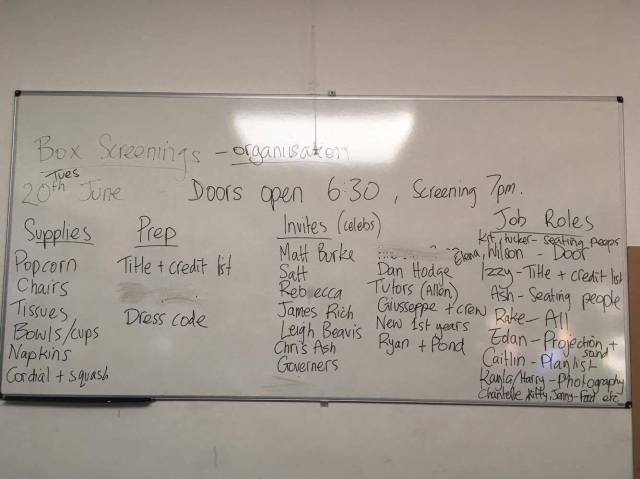
Izzy has taken it upon herself to put together a program of what’s happening with film titles and screenshots. She asked us all to provide her with with something fitting that description.
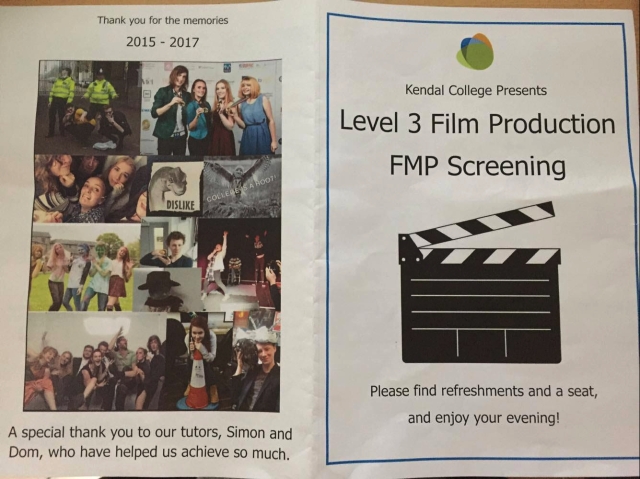
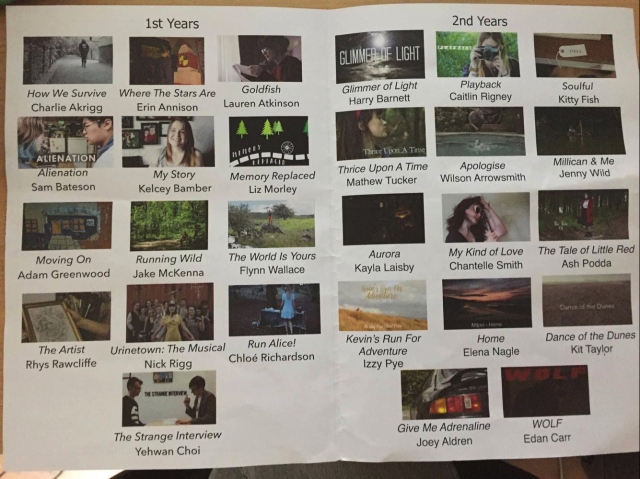
Here is the one I prepared for my film:

We are also required to present our own films with a small introduction.
Draft:
Hello, my names Tucker and my film is about how people can empathise with and relate to characters, I used traditional fairy tales to illustrate this. Its a fiction film and a little bit abstract but I really enjoyed working on it and I hope you like it
Final:
- Hello + Name
- Film Name: Thrice Upon A Time
- Empathise with and relate to characters
- Focus on editing and Visuals
- Enjoy
Online release –
Another way for me to showcase and distribute my film is with the use of social media.
I will be uploading my Film to Vimeo and Youtube as well as linking to it from my Twitter and Facebook pages. This allows my film to be seen by a much wider audience hopefully generating exposure for my work. I have created an online presence for my film related work and portfolio in a previous project and so will be making use of that here. I also Posted updates to my Twitter and instagram accounts during the project.
Vimeo credit section:

Facebook Page:

Film Festivals –
During the final stages of my film I was very careful only to use music/sound effects that were completely free and legal to use so long as I gave the appropriate credit. This means that I can publish and share my film anywhere as well as have the opportunity to enter it into a selection of film festivals.
Film Screening Photos –
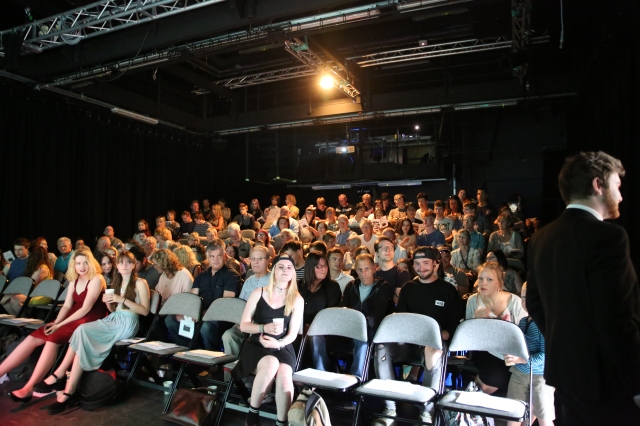
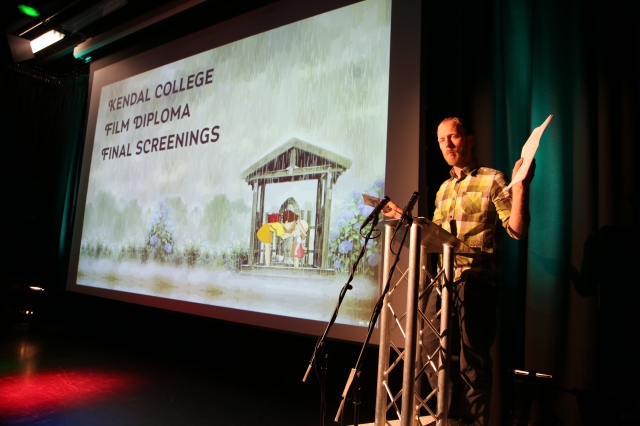
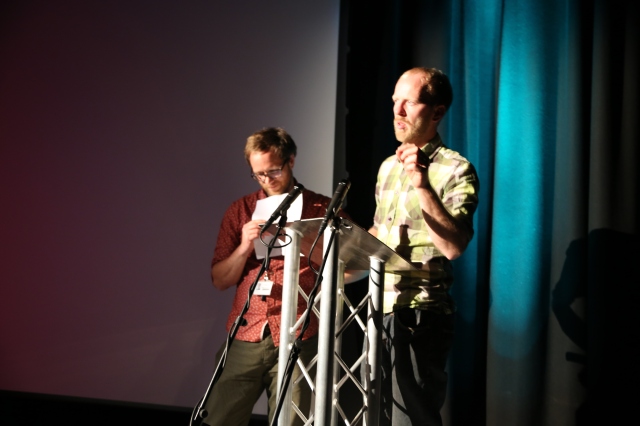
Posted in FMP Year 2
1 Comment
Project Diary & Organisation- FMP Year 2


Key problems –
- Weather – While filming Red Riding Hood we had some really heavy rain which made it difficult to keep ourselves and equipment dry and working. We got around this with the use of plastic bags, umbrellas, hot juice and party rings.
- Equipment Shortage – Due to the limited amount of equipment it been difficult to book Kit out. We managed to cope however by organizing and trading things between ourselves and making sure Satt knew what I had at all times.
- Busy Schedule – My actress has a very busy lifestyle and does a lot so it was tricky to find days where we were both free to film. We worked around this by keeping a constant line of communication open
- Disagreements – Unfortunately this project wasn’t without drama. Mine and anothers idea had similar elements to them and that wasn’t taken very well by him. I managed to avoid too much trouble by just distancing myself from him and concentrating on my own work without worrying what was being said behind my back.
Rough cut feedback 7/6/17
In order to generate effective and valuable feedback we had an initial screening for the rough cut of our films.
key points
- Cinderella colour/exposure – The exposure of this scene is very bright and doesn’t match the rest of the film. I hadn’t done any colour correction yet but this has highlighted the importance of matching the shots not only within the scenes but between them as well and will be something that I aim to improve.
- Don’t fade to black (Red) – At the start of Red Riding Hood I cut to black before she started running. This broke the flow of the film and it was suggested that this would be a good place for the title to make it feel more natural. I think this is a great point and will be making adjustments to it.
- Trim Tower (cheesy) – The shot of cinderella in the tower was held on for quite long and is slightly cheesy. The feedback suggested that I trim the shot as much as possible and do the same for any other cheesy moments. This is something that I will do, as well as tighten the scene as a whole.
Posted in FMP Year 2
Leave a comment
Production Development & Evaluation – FMP Year 2
Logging Rushes –
In order to make my editing process more efficient the first thing I did was log all of my footage and assets. While naming my shots
I made sure that everything was in the appropriate folder and subfolders to quickly locate anything:

While naming my footage I made sure to add the framing, motion, content and take number of the shot. This meant that I would know what every single clip contained without having to watch it back, allowing me to quickly locate anything I needed. I’ve also noticed that when I’m naming footage it helps if I give it a unique or funny name as it stands out in my mind clearer and I can remember more details about the shot. This is fine as long as I’m the only editor, if there were multiple people working on an edit with the same file system this could become a hindrance to them.
Shoot evaluations
Red Riding Hood –
- Rain – Unfortunately on the day of filming there was very heavy rain which caused a few problems for us. First of all it was difficult to keep all of the equipment dry while filming. We managed to combat this by covering the camera in a plastic bag and staying underneath a couple of large umbrellas which seemed to work fairly well. On the other hand though the dull lighting and rain I feel has added an awful lot to the aesthetic of the shots and feel of the scene which has been very effective.
- Crew enthusiastic – One of the main things that helped us keep going through the rain was the fact that everybody was really enthusiastic and ready to just power through it. This made working together easy and allowed for a smooth process.
- Shot list – Having a complete shot list that I could tick off while filming was very useful as it allowed us to quickly work our way through things and do multiple takes. Also it meant that because I wasn’t struggling to remember shots it gave me the head space to come up with additional shots and angles as we went along, giving me many more options in post.
- Contrast of Colour – I was really really happy with the way that these shots looked on camera. I think that there’s a great contrast between the red and green that make her stand out really well. I had decided to use the C100 because it was the best available camera for colour and it performed brilliantly.
- Some shots could be better – Although I’m extremely happy with the way that the shots have turned out I think there are some that could have had more care and attention given to them, in order to achieve a better framed and smoother shot. This was due to the poor weather as it meant that we wanted to move as quickly as possible, resulting in certain shots suffering.
Snow White –
- Colour – Again the C100 shows it true colours… I really like the way these shots have turned out, there a strong amount of contrast between her and the background making her stand out as well as being very vibrant overall which is how I wanted this scene to be as it shows Snow White’s character really well.
- On loop – While I was getting everything set up I played the music I was intending to use so that Kit and Georgie had plenty of time on their own to work out a consistent routine. This also meant that I had a good idea of how things were going to look as I positioned shots. It proved to be a really effective way of doing things.
- Sunshine – What really helped to bring out the shots as well was the fact that we had gorgeous weather while filming. I personally feel that areas of strong sunlight you see in the shots helps to give them a little more life and energy. It also meant that the whole process was very laid back as we had plenty of time and were in no rush to get inside. This allowed us to get some really strong shots for this scene.
- Lots of takes – I made sure that we did plenty of takes as not only did this mean I would have lots of angles and shots to choose from but also that we had really strong continuity because the routine was well rehearsed.
- Specific close ups – One of the videos I watched for my research into dance videos made use of close ups to highlight key moments or moves. This is something that I decided to use in my own film and think that the shots I have got will add great amount of contrast and energy to the scene.
Cinderella –
- Over exposed – Unfortunately a number of the shots were overexposed and not up to the same standard as other scenes. This is due partly because it was very overcast making it difficult to expose the sky without underexposing her. Also this was the day we had the least amount of time to film meaning that things became slightly rushed as we had a lot to get through. I do think however that I should be able to fix most of this with some colour correction.
- Windy – I had taken the pumpkin with me mounted on a tripod so that I could see if it would work. It is however quite windy up there and so I had trouble getting it to stay still as the wobbling would massively ruin the effect. In the end I decided that I would go for my backup option of adding it in afterwards as it would save me a lot of time and effort. I just had to make sure I framed it with the pumpkin in mind.
- Depth of Field – Unlike my other scenes this one doesn’t have as nice of a DOP. The other have a very shallow depth of field which helps to add depth to the image. I struggled to achieve that with this one due to trouble getting the exposure right, however my tutors have suggested I blur part of the image slightly to try and fake the effect.
- Circle shots – I wasn’t overly sure about these shots but I think the one taken from inside the circle has worked surprisingly well. I was intending to use them as a way to flesh out parts of the scene but I think that they have turned out quite well on their own and capture some good moments from my actress to illustrate the character.
Kitchen –
- Reschedule – Unfortunately when we came to shoot this scene there was condensation in the lense that I had failed to notice when checking equipment. This was because we filmed Red Riding Hood the day before. I had to cancel the shoot so that I could dry out the lense by simply leaving it in a warm room and rearrange for another day.
- Simple shots – This was by far the simplest shoot as all the shots were really simple with minimal setup. This meant that the whole process was very quick and easy to do.
- Lighting – I think the lighting in the living room worked really well as there was a lot of natural light coming in that I could use and lifted the images nicely. The kitchen however I feel could be better. It was more difficult as I didn’t have as much natural light but managed to use the bounce boards to light my scenes slightly although not as much as I’d hoped
Rough Cuts –
This is the initial rough cut of my film minus the Cinderella scene.
- Cuts together – Both in Red and Snow I think the sequences cut together fairly well and flow nicely into each other especially with the whip pan which works extremely well. There are places though where it definetly needs tightening up slightly especially in Red so that the shots are a lot snapper and reflect her haste better.
- Howl – I found some wolves noises and howls in the public domain which I have used at the start of Red. I think they are very effective in establishing the surrounding wolves although they need to be more subtle and better mixed with the other sounds to make them sound more natural.
- FleetWood Mac – For the dance in Snow I had intended to use FleetWood Mac – The Chain as the music because I thought the pace and build were perfect for the scene. After getting feedback from Simon and Dom however I feel it isn’t appropriate for her character as well as the fact that I wouldn’t be able to enter it into film festivals and Youtube won’t allow the track on the video. I would like to find something with a similar pace and feel but is a lot more expressive.
- Close ups – I think that the close ups I’ve decide to use within Red and particularly Snow work really well. They really help to add contrast to each scene as well as add a lot more energy too.
Rough Full & Class feedback –
In order to generate effective and valuable feedback we had an initial screening for the rough cut of our films.
Overall the feedback was very positive people seemed to like how I had cut the sequences together a lot and especially focused on the whip pans.
There were some points on which people suggested I could improve upon however, which was very helpful as it confirmed feelings that I had as well.
key points to improve
- Cinderella colour/exposure – The exposure of this scene is very bright and doesn’t match the rest of the film. I hadn’t done any colour correction yet but this has highlighted the importance of matching the shots not only within the scenes but between them as well and will be something that I aim to improve.
- Don’t fade to black (Red) – At the start of Red Riding Hood I cut to black before she started running. This broke the flow of the film and it was suggested that this would be a good place for the title to make it feel more natural. I think this is a great point and will be making adjustments to it.
- Trim Tower (cheesy) – The shot of cinderella in the tower was held on for quite long and is slightly cheesy. The feedback suggested that I trim the shot as much as possible and do the same for any other cheesy moments. This is something that I will do, as well as tighten the scene as a whole.
Another Rough Cut –
This is a later Rough Cut where I have acted upon a few points that were suggested as well as my own.
- Moved Title – It was suggested that I replace the cut to black in Red Riding Hood with my title. I think this was a good decision as now the intro feels a lot more natural and flows into the rest of the film.
- Transition into Cinderella – The whip pan from Snow White into Cinderella works well visually but the music transition is really jarring and doesn’t work at all. This was confirmed when I emailed a copy to Simon who suggested I embrace the fact that the music needs to stop and distort it in some way.
- Short Tower Shot – One of the things that Dom picked up on was, when she pops out of the tower window with a big grin on her face the shot was far too long which made it extremely cheesy. I have shortened the shot as suggested and think it now flows much better.
- Open Book Music – A decision I made while editing was to fade the music back in during the final scene as she opens up the book again. I really like this and think it is effective in solidifying the idea that she can move in and out of these worlds/characters. It also will help me go smoothly into the credit section of the film.
- Cross fades – I’m really guilty of overusing cross fades as Simon has pointed out to me. I Personally like them for specific moments but have definitely used to many in this cut. I think I will listen to Simon and replace/remove them, it will also allow me to prove to myself that I don’t always need to use them.
- Cinderella music – The piano track that I’ve used I think is suited well to the scene and her character and helps to tie the whole thing together so that it runs smoothly from shot to shot. The long synth track that I used however in an effort to transition from the previous scene I think is far too invasive and will probably remove it.
- Snow Music – I managed to find a track that has a nice pace, is expressive and also royalty free. I think it works a lot better than previous tracks I tried such as Fleetwood Mac and is very reflective of her character. It also allows me to enter it into film festivals.
- Foley – I did a reasonable amount of foley for this film including, footsteps, atmos, kettle noises, vocal recording etc and I’m really pleased with how well it came together. One of the things I wanted to do in Red Riding Hood was build a strong sound scape and think I’ve achieved that. It also means that I’ve had to source very few sound effects, keeping my work original, but the ones I do have are either under an attribution license or in the public domain.
Final Film and Evaluation –
Overall I think this has been a very successful project and I’m really pleased with the final outcome. There are still areas that I would improve upon in the future such as doing a more professional job of the pumpkin and improving the quality of certain shots within Cinderella. However I’m really satisfied with the result.
This project has given me the chance to try out new things such as forced perspective shots while also improving in my weaker areas such as foley work and directing actors. I also decided to play to my strengths however within editing and visuals and feel that they have also improved and hopefully will continue to. My idea has developed and changed as I’ve gone along but I feel still has strong roots to the development stage.
I’ve really enjoyed making this film and think it will be extremely valuable for my portfolio while putting me in good stead for university. I hope to continue making films like this while also seeing how far I can branch out and push my work.
Posted in FMP Year 2
Leave a comment
Pre Production & Planning – FMP Year 2
Final Story Structure –

After progressing through the idea development stage This is the final structure I have decided upon for my story.
Red
- Atmos & wolf Sounds
- Red is walking through the forest
- She hears a howl and turns panicked
- Cuts to her running frantically through the forest
- She pauses and looks around before continuing her sprint
- She tumbles and falls
- Cuts to next scene
Snow
- Follows the progression of her dance routine and music expressing her character
- Cuts abruptly to next scene
Cinderella
- Sat with pumpkin deep in thought
- Moves to in front of the tower
- places pumpkin down and walks in a circle around it
- The pumpkin begins to grow
- Amazed and delighted she climbs the tower to see
- Upon hearing a strange noise she turns away
- Cuts to next scene
Kitchen
- Kettle boils
- She puts the book down
- She makes a brew
- Sits down and continues to read the book
- Cuts to credits
Alongside the Testing and development stage I wrote out quick rough shots lists for various scenes until I was at a place where I felt my shots linked in well and were clearly defined.
Rough lists –
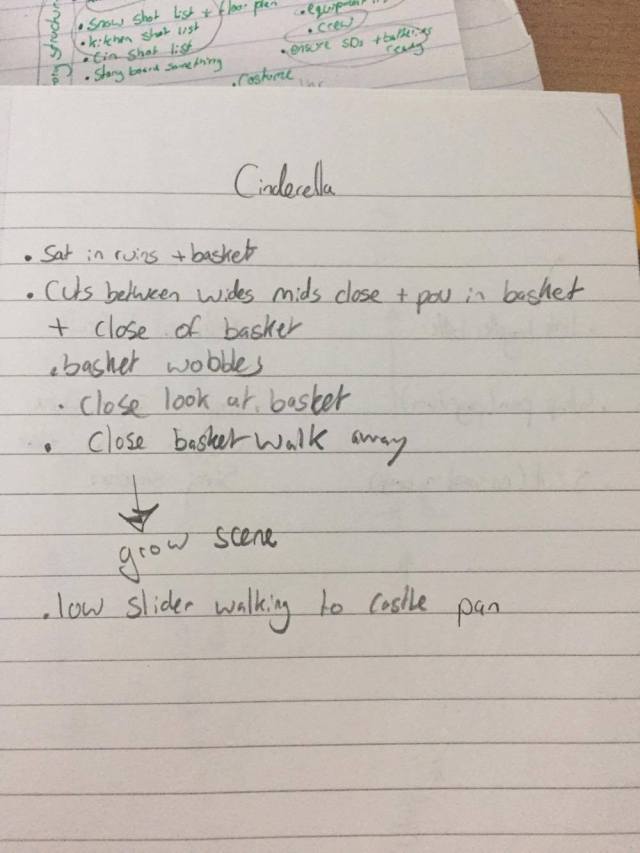
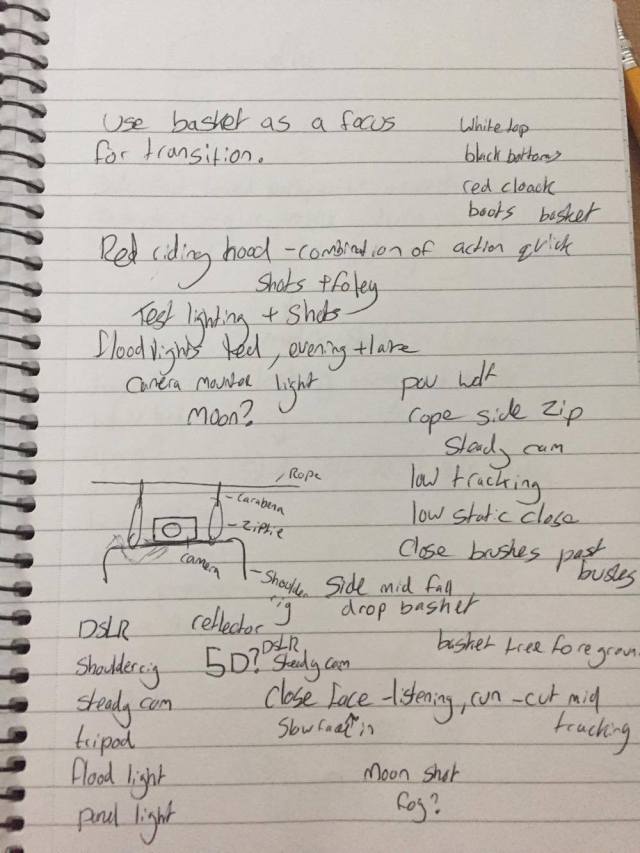
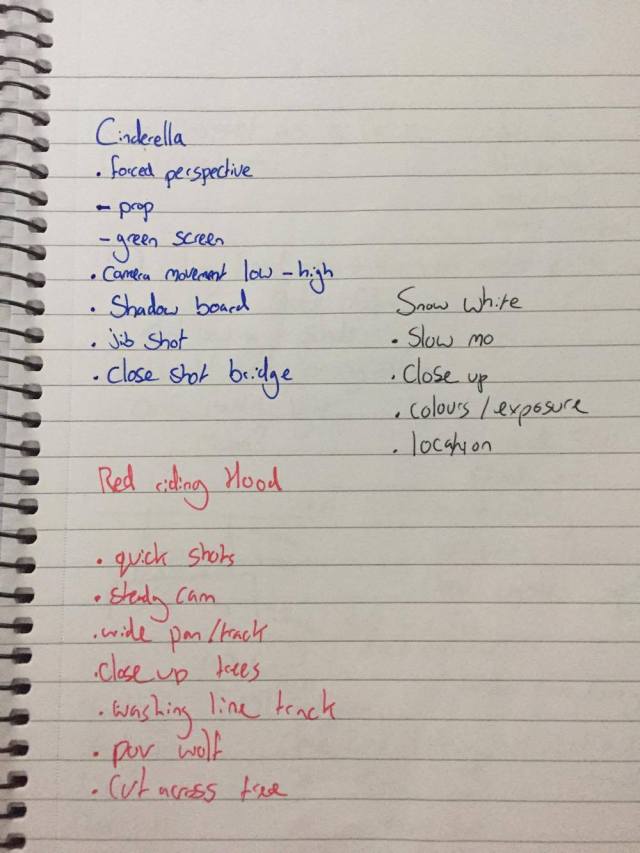

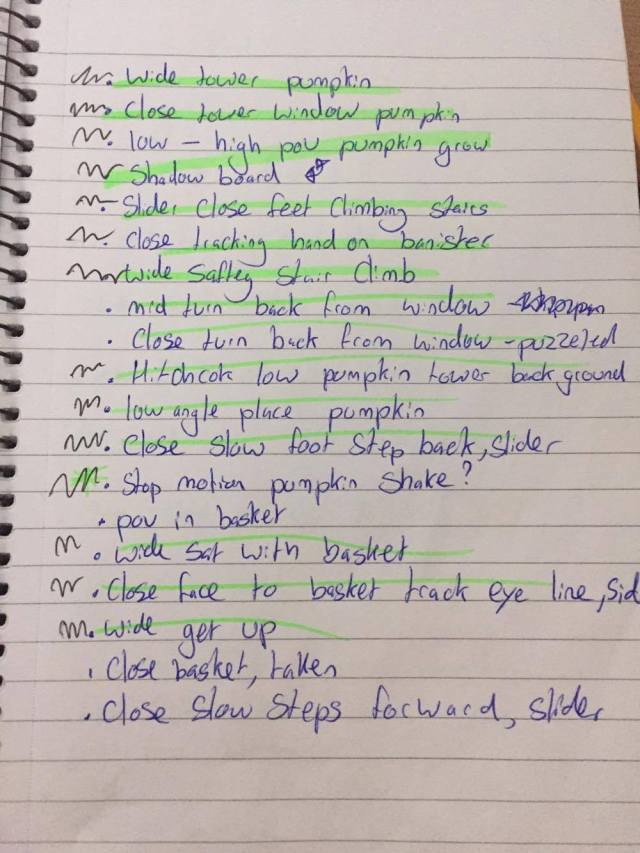

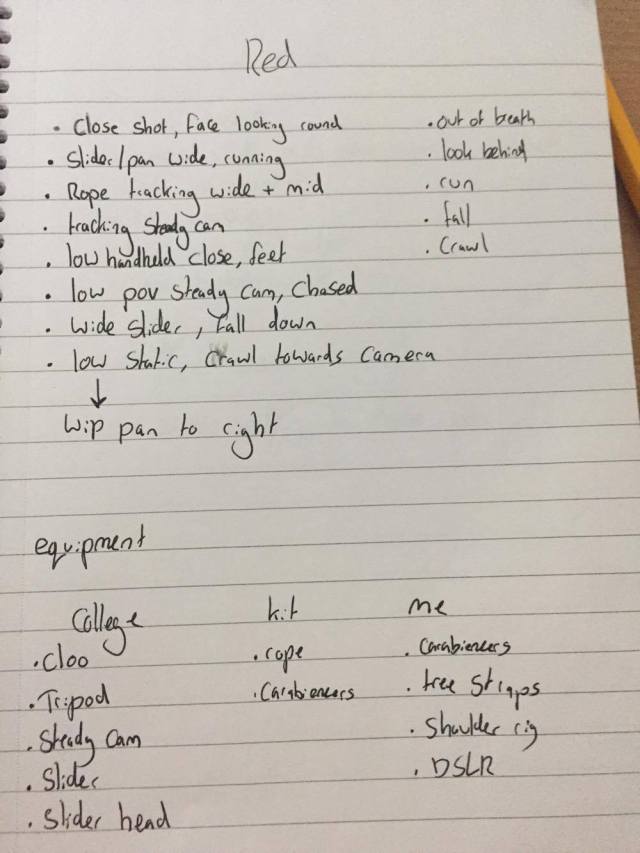
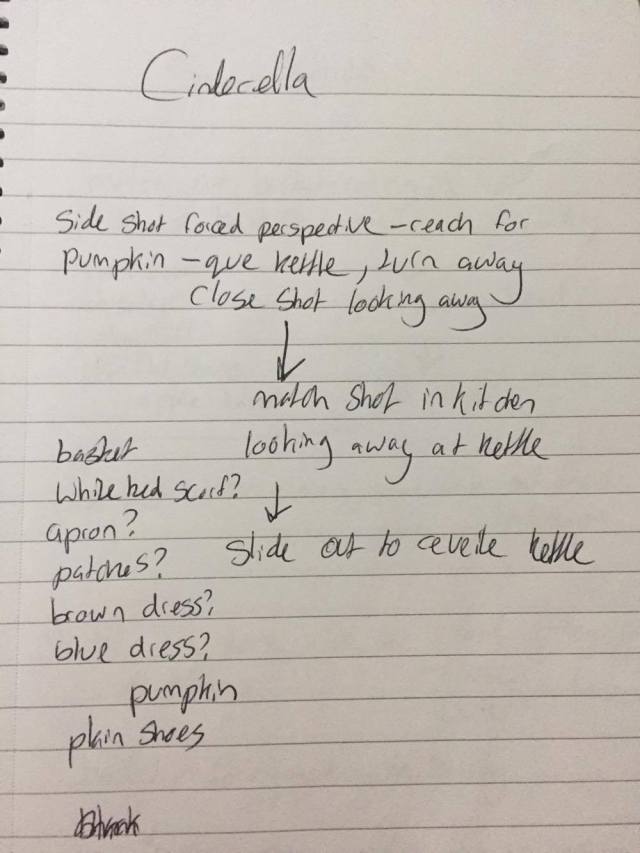

Once I’d been through the process of testing certain shots or styles out and generated drafts of shot lists I was at a point where I could compile my final shot lists together.
Final shot Lists –
Red –
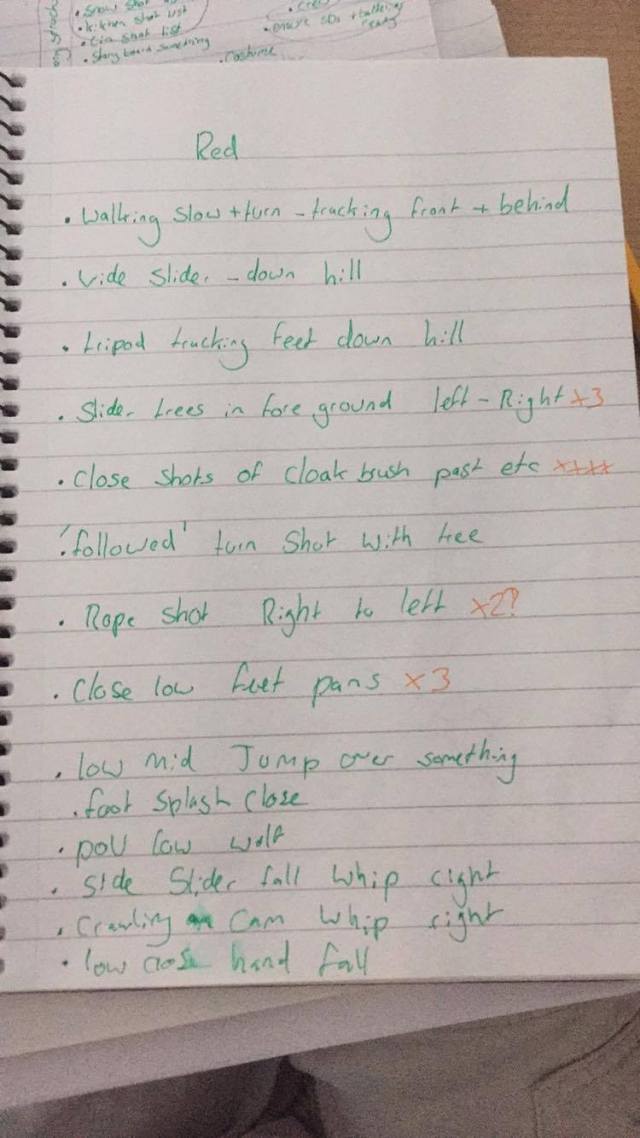
- Walking Slow & turn – Tracking front & behind
- Wide slider – down hill
- Tripod tracking feet down hill
- Slider trees in foreground left – right
- Close shots of cloak brushing past
- ‘Followed’ Turn shot with tree
- Rope shot right to left
- Close low feet pans
- Low mid jump
- Foot splash close
- POV low wolf
- Side slider fall whip right
- Crawling mid whp right
- Low close hand fall
Snow White –
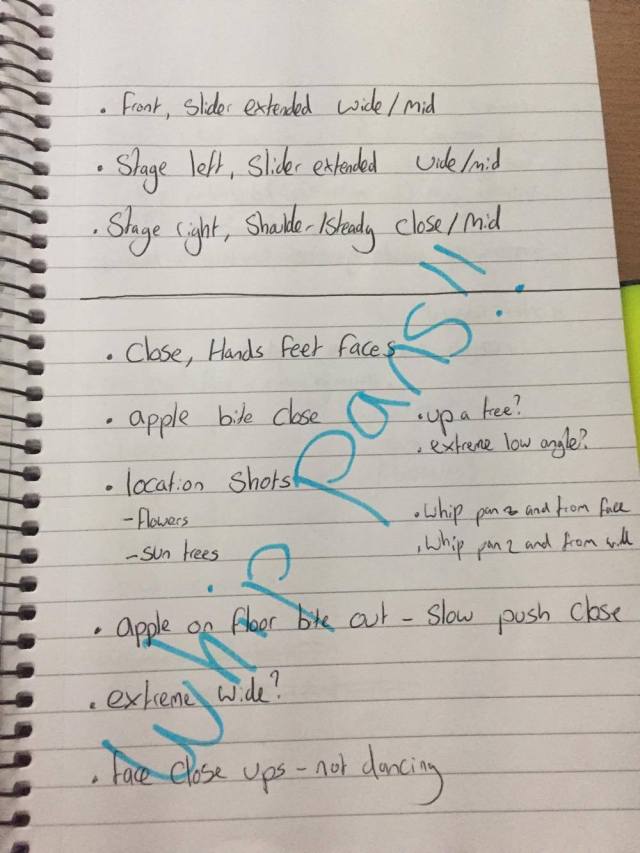

Main cameras:
- Front slider extended wide/mid
- Stage left slider extended wide/mid
- Stage right shoulder rig close/mid
Other/specific shots:
- Close hands feet faces
- Apple bite close
- Location shots
- Apple on floor slow push in
- Face close up (not dancing)
- Whip pan to and from face
- Whip pan to and from wide
Cinderella –
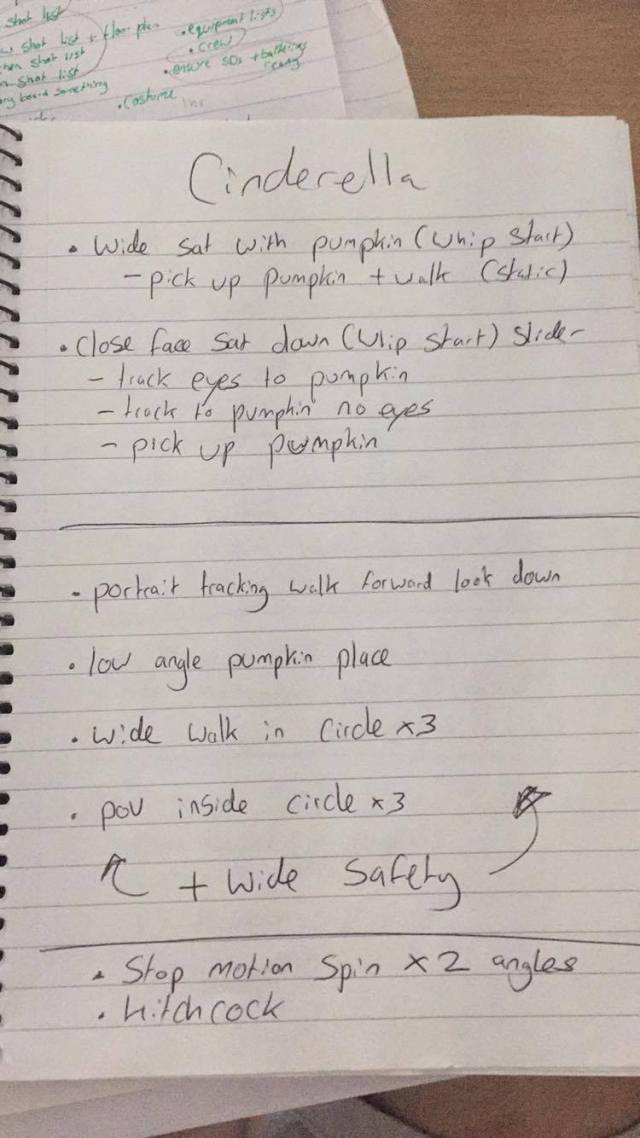
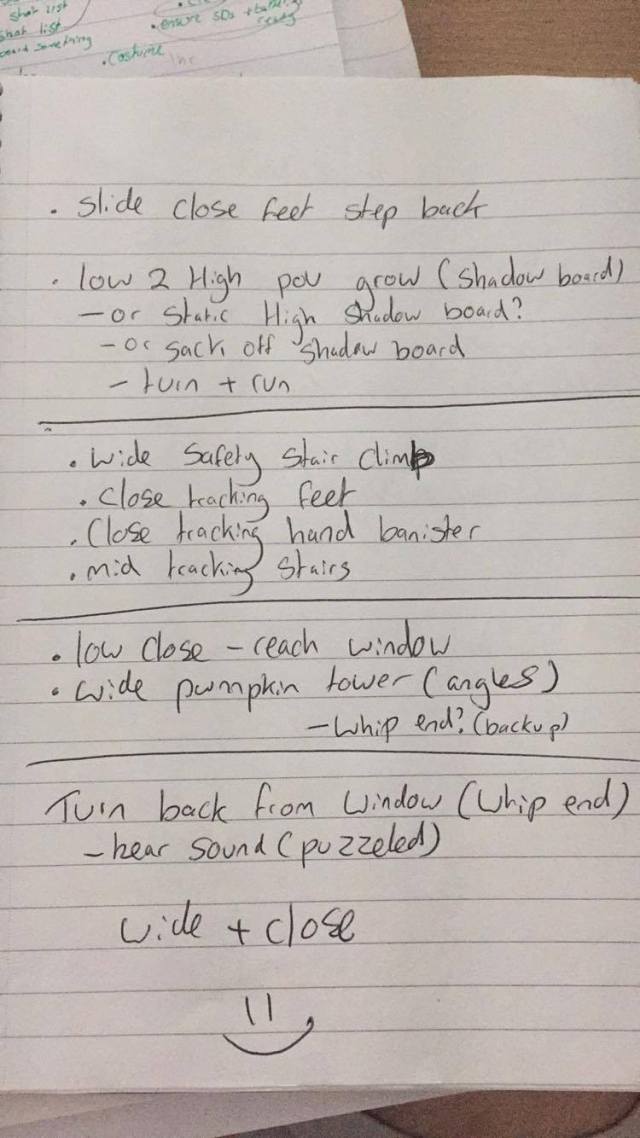
- Wide sat with pumpkin (whip start)
- Wide pick up pumpkin & walk (static)
- Close face sat down (whip start) slider
- Track eyes to pumpkin and pick up
- Portrait tracking walk forward look down
- Low angle pumpkin place
- wide walk in circle
- Pov inside circle
- Wide safety
- Stop motion spin
- Hitchcock pumpkin
- Slide close feet step back
- Low – high pov grow (shadow board)
- Wide safety stair climb
- Close tracking feet
- Close tracking hand banister
- Mid tracking stairs
- Low close & wide reach window
- Wide pumpkin tower
- Turn back from window (whip end)
Kitchen –

- Whip pan – kettle boil – close & mid
- Close kettle click
- Close water meter
- Close water pour & stir
- Close place book on counter
- Close pick up mug and book
- Wide sat down & read
- Close sit down & read
- Close mug on table
- OTS page turn (or extreme close)
- Location shots
- Close face reading
Final Shot Lists for shooting
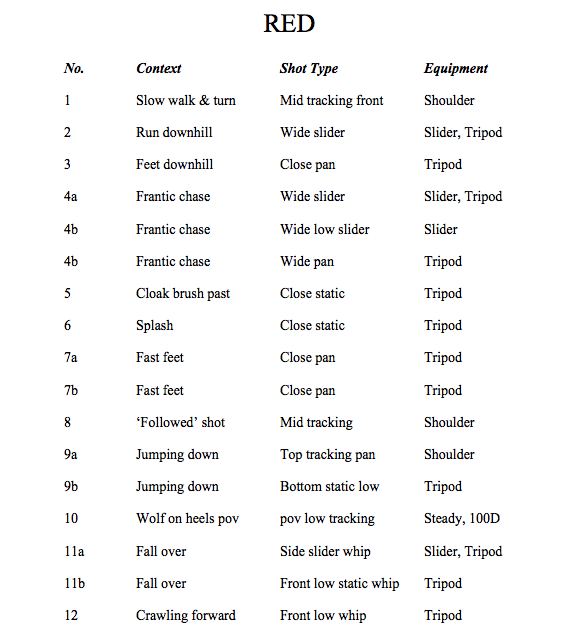


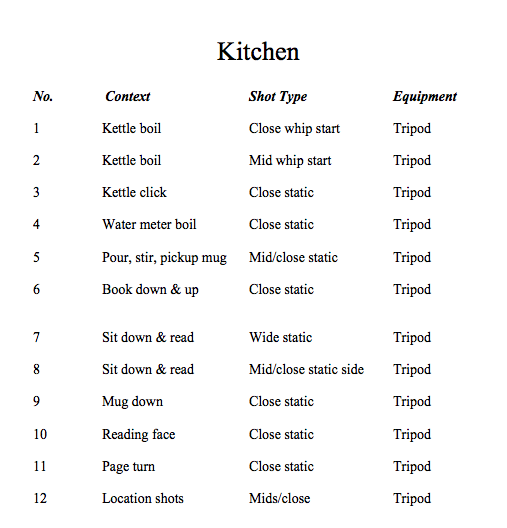
Locations –
Priory (Ulverston)
This was one of the first locations I visited. I thought it would be ideal because there is a great diversity in the types of forest areas catering for both red and snow as well as the building itself which would be perfect for cinderella. Also having most of the filming in one location would make logistics a lot easier. I emailed the Priory to try and get permission but once I had correspondence it was apparent that this wasn’t an option as there was a festival taking place when I would need to film.

Holker Hall (Ulverston)
Another place I looked at was Holker Hall. I thought that this would be a suitable location for the Cinderella scene because of the manor house type feel. I contacted them also to try and get permission but unfortunately I didn’t get a reply.

Springies (Ulverston)
I thought this would be a useable location for the snow white scene. I wouldn’t need permission to film there as it is owned by the woodland trust. I quite like the type of trees there and think they would be reflective of snow white but was disappointed by the lack of flowers or greenery. Therefore this will become a backup location.
Sea wood (Ulverston)
Another location I thought would be suitable for Snow White is Sea wood. This is also a public wood so I wouldn’t need permission also it is fairly secluded so I wouldn’t run into too many people while trying to film. I thought it was much better than Springies as it had the same style but had much more colour present from flowers and undergrowth, as well as being in a good position to catch the light through the trees.
Kendal Castle
Due to the fact that I wanted some sort of structure to help establish Cinderella’s scene I thought this might be a good choice. I wouldn’t need to get permission to film there and logistically it will be great because my actress is from kendal. However I will potentially run into passers by that could make filming tricky. I quite like the idea of the castle as to me it pays homage to key aspects of her story but that fact that it’s in disrepair I think add something else, as though that life is behind her now.
Great Knott Wood (Newby Bridge)
This location I thought would be perfect for Red Riding Hood. It has exactly the kind of trees I was looking for, really tall and ominous, which I think reflects the themes from this scene really well. It is also owned by the WoodLand Trust meaning that I don’t require filming permission while also being very secluded. There are draw backs however, Logistically it could be difficult as it’s difficult to give directions to so I would need to pick everybody up and drop them off. Also there is a bit of a trek up to the location from the carpark which could be problematic if I have a lot of kit with me.
Georgie’s Kitchen (Kendal)
Another location I need for my film is a kitchen with a homely atmosphere. Thankfully my actress was kind enough to offer her house which would be ideal logistically. Also her house has a very homely almost rustic feel to it. Her feeling comfortable in this location will also help as that will hopefully come out in her performance, where this scene has those kinds of feelings attached to it.
Final Locations –
The final Locations I have chosen for my Film are:
Red Riding Hood – Great Knott Wood
Snow White – Sea Wood
Cinderella – Kendal Castle
Kitchen – Georgies House
Equipment lists –
Red Riding Hood:
- C100
- Tripod
- Slider
- Slider head
- Steadicam
- 100D
- Shoulder rig
- Umbrellas
- Rope & accessories
Snow White:
- C100
- Tripod
- Slider
- Slider head
- bounce board
- Shoulder rig
Cinderella:
- C100
- Tripod
- Slider
- Slider head
- Bounce board
- Shadow board
- Zoom Lense
- Shoulder rig
Kitchen:
- 100D
- Tripod
- Bounce board
I will also need to check that I have charged batteries, formatted SD cards, cleaned lenses, checked camera settings etc
Crew –
In order to keep things simple I will be using quite a small crew as I will be able to do most of it myself but will need a hand with specific things.
Georgie (Actress) – I will only be using one actress for this film to play all the characters as I decided. I have decided to use Georgie for this film firstly because she is a really talented actress but also because I get on well with her making it easy to work together. Also she is quite an accomplished dancer and says that she will be able to choreograph/improvise a dance routine in the style that I have shown her. In addition she has control over the costume cupboard making is easy for her to source particular items and leaving me to just get the more stylized items.
Kit (Crew Member) – I have worked with Kit on a number of occasions and we have always worked extremely well together. The main reason I have asked Kit as well is because he has also had experience with dance so will be able to assist Georgie with choreography. He also has good technical knowledge of equipment and cameras so will be able to help me solve any problems should they arise. Finally he is very reliable and will turn up if he says he will.
Costume –
The costumes within this film will be very important in establishing characters. That is why I have decided to keep as close to the original colour schemes and outfits as possible. In order to source these items the vast majority Georgie will own or be able to borrow, the others I can source from amazon and charity shops.
Red Riding Hood:
I managed to find a red cloak and basket fairly cheaply which I think have worked really well in establishing the character. I left Georgie to find a white top and black pants to go with it. I felt that simple was best here.
Snow White:
Georgie managed to get hold of the skirt from the drama cupboard which I think is effective. I only needed to get hold of a blue top and head band. The Jacket I found in a charity shop and the headband from amazon,
Cinderella:
Originally I was going to go for the ‘rags’ version of Cinderella. However Georgie had a nice simple blue dress which I think has worked really well as a budget version of her extravagant dress. I was left to source a headband to complete the look. There is an obvious difference between hair colour but I felt that was fine as the film is about how anyone can empathise and relate to the characters.
Kitchen:
For this Scene I just asked her to wear anything comfortable such as a warm jumper to try and reflate the emotions at this stage of the film. Again For this I felt that simple was best.
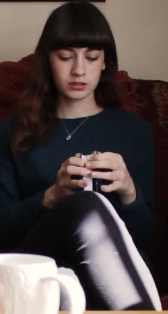
Risk Assessments –
Overall
- Equipment Issues – While filming there are a number of things that could go wrong in relation to equipment usage such as: dead batteries, full SDs, dirty lenses or missing pieces. This would impact the filming process by slowing us down and potentially having to cancel. In order to avoid this I will need to check all equipment prior to each shoot and keep on my person a checklist of everything we have and need.
- Time limit – On a couple of the shoot days time will be limited due to other commitments from myself or my crew this means that we will have to work quickly which could easily make things rushed. To make this go as smoothly as possible I have fully prepared as much as possible for the shoots and briefed my actress and crew ready for it.
- Improvised Dance – The Snow White scene is comprised of a dance routine that will be choreographed/ improvised by georgie. Obviously because it is improvised it could take a while to perfect and arive at something that we’re both happy with. To make this easier with have a lot of time on this particular shoot and I have asked kit to accompany us as like georgie he is also a talented dancer and can assist her.
- Windy Pumpkin – Due to kendal castle being on top of a hill it has the likelihood to be quite windy during filming meaning that getting the pumpkin to stay in place particularly for forced perspective could be extremely difficult. If this proves to be the case my backup plan is to use the other method I tested of adding it in after. This will help save time and relieve stress as this is one of the days we are limited on.
Red – There are a couple of points that will really only apply to the Red Riding Hood shoot day
- Slippery, Cold, Wet – On this particular day the forecast isn’t great and because of the location it could become very muddy/slippy. Also being stood out in the rain for too long and people might start to feel wet and miserable. To try and make this go as well as possible i’ve instructed everyone to wear decent shoes and bring a good jacket. I will be supplying umbrellas, warm drinks and biscuits in an effort to keep everyone happy.
- Damp Equipment – Because the forecast to so terrible it will also be an effort to keep gear dry. A lot of what i’m taking can be stored in bags and cases as they are either waterproof or easy to dry. The camera in particular however will be more difficult. In order to keep it dry I will be placing the body and most of the lense into a plastic bag while keeping it under the umbrellas the entire time.
Posted in FMP Year 2
Leave a comment
Pitch & Feedback – FMP Year 2
22/3/17
Initial Pitch (elevator Pitch)
In order to generate feedback with which to develop our films everyone is writing a short pitch of their current main film idea. We will then constructively criticize each others proposals giving us a collection of feedback to help evaluate and develop our ideas.
Draft 2 (final) –
My film is about a young woman sat reading traditional fairy tales on a train who then starts to envision her self as the main characters.
This is inspired by the difference between imagination and reality as well as how books are the boundary or ‘horizon’ between them.
The film will feature one leading actor playing the main roles of traditional fairy tales such as, Red Riding Hood, Hansel and Gretel or Snow White, showing how readers can empathise with characters and put themselves in their shoes. I plan to focus on key visual moments that are recognizable from the selected fairy tales, for example with Red Riding Hood I might show her running through a dark forest with a red jacket and picnic basket coupled with the sound of wolves in the distance.
Towards the end of the film I will cut back to the reality of her sat reading on a train. I plan to do this by fading in the sound of a train conductor/announcement just before I cut from the last fairy tale. I also aim to make this cut at a climatic moment such as just before she kisses prince charming or gets eaten by the wolf.
23/3/17
Feed Back Generation –
Into order to generate effective feedback we went round and left comments on each others ideas:
- “This is a good starting point for a film and it is a very relatable subject, especially amongst young people. I would give more thought as to what specific challenges she is going to face and how she is going to overcome them.”
- “I really like this, super original. How will the stories link together? I think thats the only thing you need to look into? Maybe mix the stories together somehow? So there isn’t starts and stops. Create a flow.”
- “Love it, got no faults, well done dude”
- “www: aesthetic appeal, cool narrative, dramatic ending. EBI: Trains are difficult to film on, lots of locations cause pain in logistical terms”
- “I think this is a brilliant concept for a short film. The concept of imagination is portrayed really well and is very compatible with the theme of books and fairy tales. I would definitely conduct tests as to how many fairy tales you want to include as this wounds like a lot for a short film.”
- “I really like this, I can see it being quite magical. I can see it being hard to do but I can see it being achievable too.”
- “The image of red riding hood would be really arresting, maybe if it was a bit blurred to start with? what about turing it on its head? Have her pull a gun out of her knickers ( Ronald Dahl – Revolting Rhymes) – feisty female in red.”
- “How are you going to make the set look like a train? could be difficult. I really like the idea of looking at how we tell stories and empathize with characters. nice. I think her getting eaten would be a more dramatic and interesting ending. How you end this film could change the entire mood of it.
- “Will you be able to fit this into 2-4 mins. Maybe you could simplify it a little?”
- “The pace of the film is very good, definite story arc and conclusion. I especially like the idea for the end scenes. Seems like a lot to cram into the time allowance, if you do too many fairy tales it could be an overload of info maybe.”
- “Try to put your own spin on the shots. Would be nice to see colour play a big part, but i love this.”
28/3/17
Key Feedback points –
These are some of the most common or valuable points that I have received as a result of our feedback session:
How they link together – How I actually transition from one fairy tale to another and the motivation behind this is still undecided. I knew that this was something I wanted/needed to address and my feedback has clarified that this is an important idea. This will mean the difference between my film running smoothly and coherently from start to finish or being too jarring and disjointed. I plan to research various fairy tales and the similarities/differences between them so that I can identify common themes that I may be able to link them with.
Specific Challenges – Although I have a reasonable idea of the flow of the film and the overall structure I have not yet settled on the actual physical content. What I mean by this is the specific moment I will feature of each fairy tale and wether these share a theme or come together to make a bigger picture. This will be very much dictated by how I decide to link them together but also I will have to choose moments that won’t require a huge production budget to pull off, as it’s none existent for this project.
Time Limit – Another common point from feedback was wether I would be able to make this idea work within the given time limit of 2-4 mins. This is something I had thought about but not included in my pitch. I feel that focusing on 3 fairy tales would be appropriate. Firstly the rule of thirds/triples is apparent in film as well as language, people tend to prefer things in groups of 3 as this feels more natural. I think this system would work as I can structure my film so that I have 1 min for each fairy tale with a 30 secs conclusion and a spare 30 secs just in case.
Versions of Fairy Tales – As part of my feedback it was suggested to me that I look at some modern versions of fairy tales and if there was a way I could incorporate them. Personally I feel that I want to stay closer to the traditional versions as I feel it will be a purer representation of how people empathise with characters. I am toying with the idea of showing each fairy tale in a different style e.g ‘red riding hood – horror’ or ‘Hansel and Gretel – Dreamlike’ and so looking at some modern takes on fairy tales might be valuable to help me stylize each section. This also made me think that perhaps I could branch out to classic children’s stories such as peter rabbit in order to have a bigger pool with which to draw inspiration from.
Trains/Locations – One common point from my feedback was the difficulties I might face from filming at a number of different locations logistically as well as the legal implications of filming on trains/stations. Although having a large number of locations could prove troublesome I think that it is perfectly doable with careful planning of shoot days and if I am fully prepared before filming on each day. The train however I think I will need to think about, I am still enthusiastic about the conclusion of her being sucked back into reality but think that I will have to find a different medium for this rather than the train journey.
Rebecca Day – Film Presentation
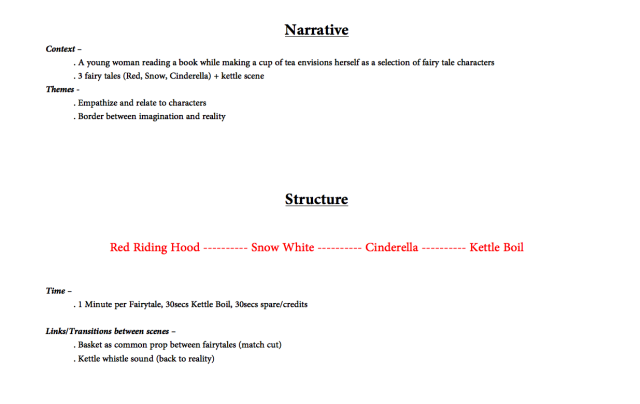


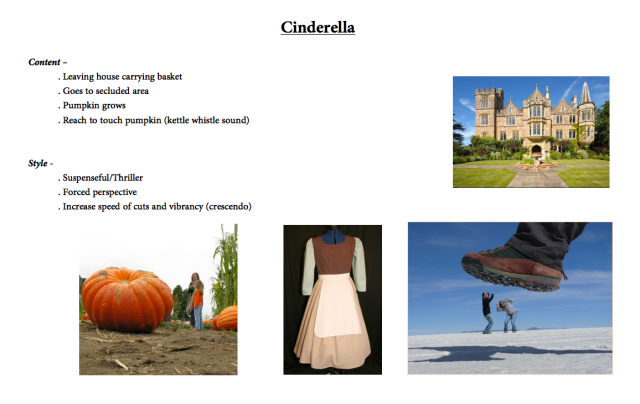

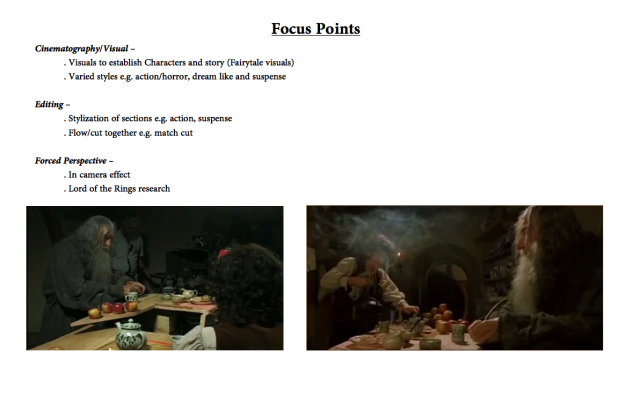
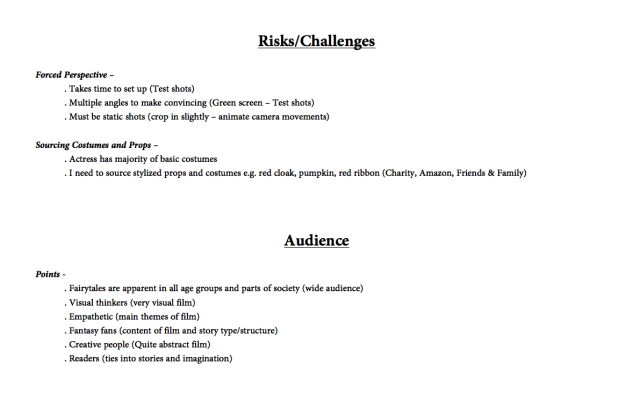


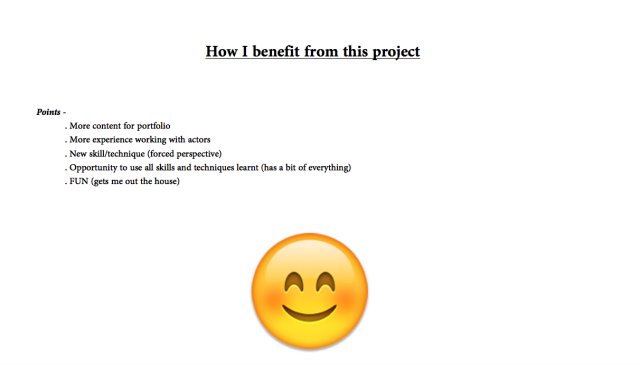
Feedback:
- Confident/nice presence/good eye contact
- Visuals helpful – Using photos from locations, mood boards and examples was helpful in illustrating the points I was making and clarifying things
- Too much text – The text on my slides was too detailed therefore distracting. Next time I should only use key words to prompt myself such as ‘Audience’
- Prompt cards – Rather than leaving my prompt on the slide I should have something separate to go through before hand so that my presentation is less cluttered
- Relevant Content – Everything in the presentation was relevant to the pitch and film
- Explain the technical things – I should always assume that the person i’m pitching too doesn’t understand the more technical aspects such as forced perspective and so should make sure I explain them briefly
- Explain narrative clearly – I went over the narrative a bit too quickly and should spend more time to make sure that it is clearly and succinctly explained.
Posted in FMP Year 2
Leave a comment
Testing & Development – FMP Year 2
This post contains various test shots of different aspects of my film
Cutting Test –
This video contains examples of me testing cutting techniques that I discovered in my research.
Whip Pan – I think this is the most successful type of cut I’ve found that I think would be effective within my film. I like the fact that it is incredibly smooth and simple way to transition between two potentially very different shots, moving smoothly from scene to scene is an important aspect of my film so I feel that it would be an appropriate choice. To me it is also reflective of a page turn in a book as it has the same kind of fluid motion, this will hopefully help show the themes of my film as well.
In order to pull this off however I need to make sure that I am always moving in the same direction on both shots so that they can be cut together smoothly. Also on the second shot I will need to whip pan into it, making framing more of a challenge. I found that if I set the frame before the shot and practice the motion, this isn’t too tricky.
Object in Frame – Although still useable I don’t think this cut worked quite as well. In order to make this work I need to have a common object large enough to fill most of the frame which could prove difficult at different locations; also the size and height of the object in each shot need to be almost identical, not to mention the lighting. This means that it is a very difficult shot to pull off with a lot that could go wrong.
As for how effective this type of cut might be within my film, I think that opportunity to have a common object to link each character would be fantastic as it would work as a visual cue to illustrate a constant theme. Im not as fond of how the cut ‘feels’ though, to me it represents more of a comma between scenes rather than a full stop and although I want the scenes to interlink and share ideas I still want there to be a clear separation of the characters. This is because the premise of my film is how people relate and empathise with different characters, so I feel that I need to also show their individuality.
Match Cut – This cut is also really hard to do and make convincing. Not only do I need to try and match the size height and lighting of whatever im using, in this case a basket, but also the potential movement of the object. Making this type of shot a nightmare to do where time may be limited and therefore making other shots suffer or be missed.
In my opinion this cut is very similar to the ‘object in frame’ one in terms of how effective it is. It again would allow for a common object or motion to link scenes and themes but is very tricky and time consuming.
Looking back at the tests I have done I think that the Whip Pan would be the most appropriate as it conveys strong ideas in my film, allows for a very smooth transition and is fairly quick and easy to do.
Pumpkin Perspective Test (Photo shopped in) –
Here I’m testing how the pumpkin will look if I decide to add it in after.
Overall I think it works reasonably well. Even though it is obviously still unrealistic I think its strong enough to still effectively show whats going on. I’ve reached the conclusion that I need to accept its never going to look perfect as I simply don’t have the budget or the time to do that. There are little things I can touch up on however in an effort to improve it such as, there is clearly a direct light source on the pumpkin which doesn’t match the soft even lighting of the shot and also I feel that the colours of the two images need blending together better, perhaps desaturating the pumpkin a little.
In order to produce this shot I first took an image of the pumpkin that I cut out in photoshop. I then imported that image into premiere, layering it over the shot of the tower, where I could adjust size and move it into a desirable location. I then found that if I masked out the bottom of the pumpkin and feathered it enough it looked much more convincing, like it was meant to be there rather than stuck on top.
I think that this may be the way in which a decide to build this shot as it gives me a great amount of control as to how the final shot looks and allows me to readjust mis en scene to an extent. Although not perfect it is still effective and means that filming is less time consuming as well as giving me more options in post.
Snow & Red style test + Forced Perspective (on location) –
This is a selection of footage I got while testing out different shots in order to get a better feel of how things will play out.
Snow – This test has allowed me to get an idea of some of the framing, camera movements and cuts present in this scene.
- I think cutting from the wide shots into mids on his motion works quite well as it ties the shots together and makes the scene more fluid. The reason it hasn’t fully worked here is because it was improvised and so his routine isn’t consistent. When I come to film I will need to make sure it is well run through before hand so that I can match the shots easier and more effectively.
- I also like the diversity between a wide slider and a closer handheld, I think this helps to add contrast within the scene and makes it more engaging to an audience member.
- I think the framing and motion of the wides and mids work well but obviously need more care and attention on the day to make the smoother. I do however think that close ups of faces and specific movements within the routine are need however in order to break up the scene more and add more interest to the dance.
Red – Here I have been able to get an idea of the pacing of the scene as well as try out the rope technique.
- One of the key things I noticed from this test was that I need far more close ups and quick cuts to add energy to the scene. The mids and wides work well to establish location but don’t have the same impact. I will need a good mix of both to make this scene work.
- The second and third shot of this test was shot on a budget version of the Harry Potter zip line technique. I strung a rope between two trees, mounted the camera on a shoulder rig and anchored it to the rope. I then moved along side Kit as I guided the camera along. This did allow me to get some relatively nice shots in terms of movement but to me seemed like nothing I couldn’t do hand held, meaning we would avoid set up time.
- In terms of the pacing and the movement I think it worked quite well and will allow me the reflect the panic of the character. I just need more shots with more diversity between camera distance.
Forced perspective – I also experimented with placing the pumpkin in different areas of the frame to see how it would look.
- One of the things I found out from this test is that setup can be very difficult and time consuming. I had attached the pumpkin to a tripod so that I could position it better in frame however because its so lightweight I was having trouble getting things to stay in the right place. Also because the pumpkin is so small it’s quite hard to get it close enough to the camera to look the right size while having a large enough DOP to keep everything in focus. This could really slow down a shoot and would be more difficult on a windy day
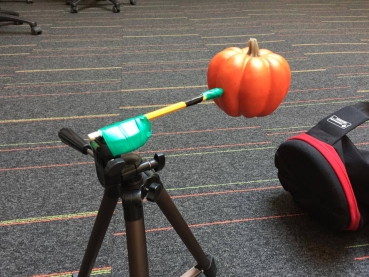
- One of the advantages of this method over doing it in post is that the lighting on the pumpkin will definitely be the same as the shot because they were both achieved together on location. Saving me time in post production but limiting my options slightly.
- One of the things I learnt was that it was tricky to instruct an actor so that their eye line was in the right direction to complete the effect. This is something that will only be achieved by carefully placing markers for my actor and rehearsing the shot, costing more time and energy on a shoot.
Pumpkin Spin Test –
One idea I had for the Cinderella scene in order to try and make the pumpkin seem a bit more magical was to use stop motion to make it look like it’s spinning really fast. I only did a really quick test of this but quickly decided that although I liked the idea I didn’t think the style would fit with the rest of the shots I had planned, distributing the flow of the scene and ruining immersion.
Last years Shot –
During a previous project I completed at college I discovered a shot that I think would also be appropriate for this film.
The shot I am referring to takes place from 0:30 – 0:36. The camera follows my actor down a corridor and then pans around to reveal what’s behind. I thought this was a really effective shot in building tension within a scene and would be great to use as part of the Red Riding Hood scene.
Posted in FMP Year 2
Leave a comment
Research – FMP Year 2
29/3/17
Fairy Tales Research –
As fairy tales will be featuring in a big part of my film I thought it would be a good idea to look at a selection of classic fairy tales and identify the themes and visuals of each so that I can see which ones would work well together.
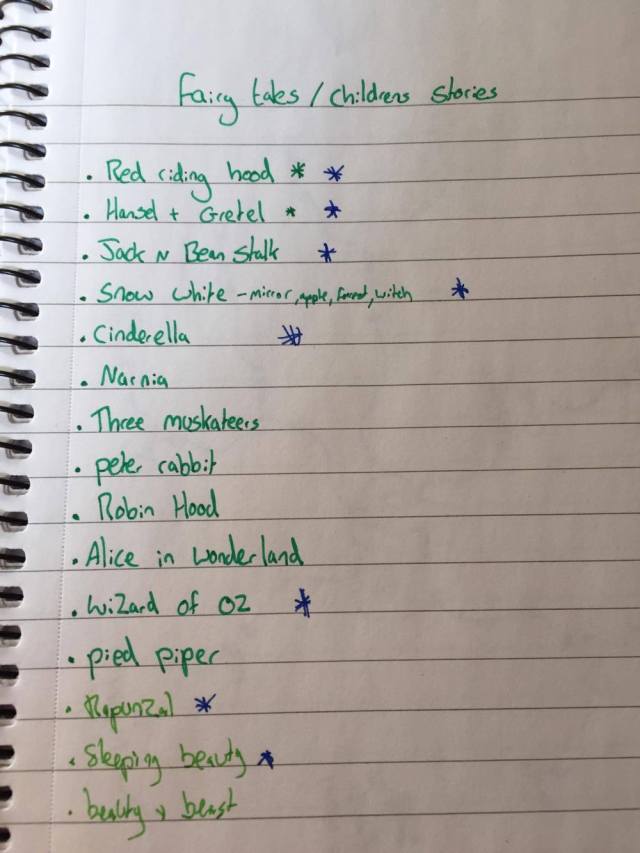
Red Riding Hood – This is the story of a young girl visiting her grandma who then gets into a conflict with The Big Bad Wolf. The moral of this story is the dangers involved with talking to strangers.
Mind map/Mood board – Identifying visuals and themes
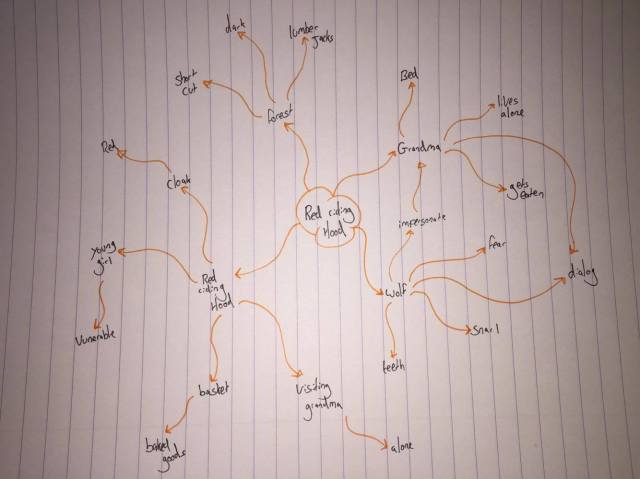
Story Text – http://www.pitt.edu/~dash/type0333.html
Good:
- Well Know – Due to this being one of the most famous fairy tales it is incredibly recognizable. This will make it a lot easier for me to establish the visuals and story as people are already familiar with it.
- Low Budget Stuff – The majority of the visuals and content in this story are very achievable and would only require basic props and costumes to replicate. This would make my production phase a lot less technical and easier to do.
- Strong Visuals – I think mainly the popularity of the story but also the contrast in colour are what make this such a visually strong and recognizable image. Starting out with such a strong image would be a great way to establish the themes of the film with the audience.
- Easy Location – The main bulk of this story is set in a woodland/forest type setting which is a really easy location to come by in my area. This means that I will have a much wider choice of locations and be able to choose the most appropriate one for this scene. I also shouldn’t run into too many problems with filming there or getting permission as a lot of these locations are public.
Bad:
- Wolf more technical – If I wanted to visually show the character of the wolf it would be considerably more difficult than the other aspects of this story. I imagine that I would either have to use CGI or be cleaver with props and lighting, both would be hard to make look visually appealing. Although if I use Red riding hood I would likely only establish the wolf through the use of sound.
- Night Filming – As I am currently picturing the potential scene for this story it would likely be set in a dark wood. This could prove problematic but not impossible. My main issue would be lighting/power but there are a few options available. I would prefer to get the lighting right on set and this would require either a generator or battery powered lights, both of which are fairly easy for me to get hold of. Another option would be to play with the image in post to try and replicate the look I want. I think doing some test shots for these method would be really valuable later on.
Snow White – This is about a jealous evil queen who wants to be the most beautiful in the land. Snow white is more beautiful than her and so she tries various tricks to kill her.
Mind map/Mood board – Identifying visuals and themes
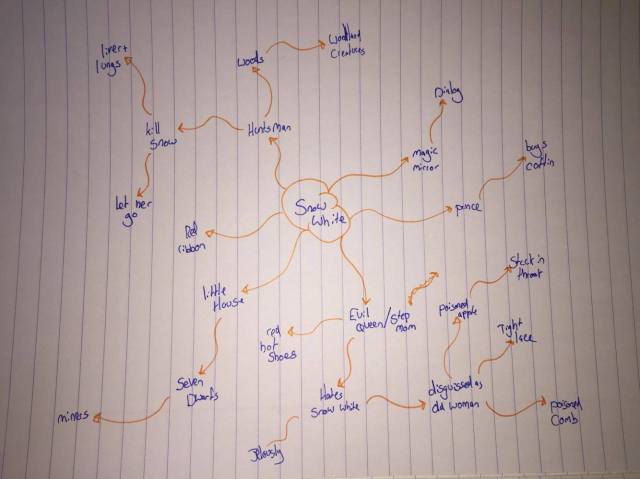
Story Text – http://www.pitt.edu/~dash/grimm053.html
Good:
- Well Know – Due to this being one of the most famous fairy tales it is incredibly recognizable. This will make it a lot easier for me to establish the visuals and story as people are already familiar with it.
- Strong Visuals – Much like Red riding Hood, Snow white is an incredibly famous fairy tale meaning that it’s visuals are highly recognizable. Also Snow white tends to make use of very vibrant colours creating a striking image.
- Lots of content – Snow white although it is a short story contains a number of different settings and scenes from which to draw inspiration. These include the dwarfs house, the woods and the evil queens castle. This means that I have a larger bank of information with which to inform my film.
- Locations Available – Similarly to Red riding hood, Snow White is mainly set in a forest type setting and these are the locations that are most easily available to me where I live. A castle also wouldn’t be out of the question as there are a number of old medieval type buildings scattered around the lake district that I could definitely get outside establishing shots of.
Bad:
- Excess characters – If I am going to cover particular scenes from the story of Snow White I would likely need a greater number of actors and therefore crew in order to properly convey each character. This would make organizing shoot days more of an issue as more people would have to be free at a certain time and make rescheduling difficult.
- Costume crucial – One of the key aspects of creating the visual of Snow White will revolve around costume/set design and this could become a problem depending on availability and price of costumes from various sources.
- Different Versions – I am currently looking at the original plot of Snow white and there are a few differences between this and the more well know Disney version. If I want to stay true to the original it is possible that my audience could become confused as the original isn’t as familiar to them.
Cinderella – This story is about a young girl and her evil step mother that forces her to work all day and stops her from going to the kings ball. She then gets given a dress from a magical source and marries the prince.
Mind map/Mood board – Identifying visuals and themes
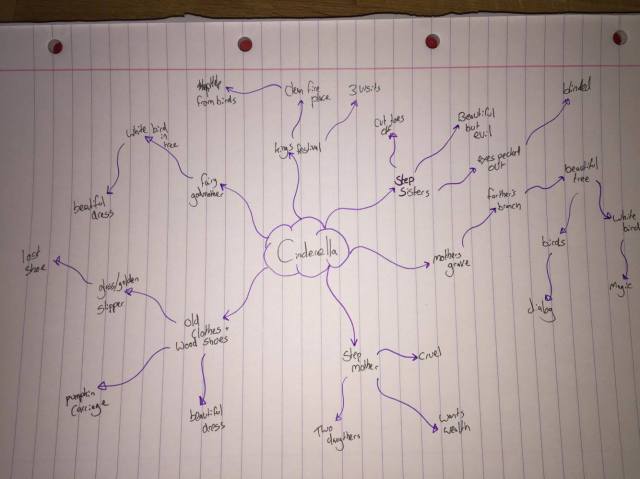

Good:
- Well known – My film will require me to very quickly establish each fairy tale. This means that a more well known character or story will be much clearer to my audience than if I used a less known one which could cause confusion.
- Strong visuals – This is another fairy tale that has a lot of strong visuals that relate to the story. This is mainly down to Disney as they like to put their own spin on things such as the fairy god mother and pumpkin carriage aspects. This means that theres a good variety of material and imagery that I can use or draw from.
- Links in – In the first draft of my story structure I had planned to use the Wizard of Oz as one of my scenes but decided that it doesn’t fit well enough with the classic fairy tale feel that Red Riding Hood and Snow White provide. I feel that Cinderella will be a much better choice as it screams classic fairy tale.
Bad:
- Locations – Unlike other fairy tales, Cinderella will require more of a structural location such as a castle or manor house type vibe. These kinds of locations will be more difficult to find and likely involve me having to get permission, although I do have a few places in mind that could work
- Expensive dress – One of the key visuals from Cinderella is the magnificent dress that she receives. This would prove to be problematic if I wanted to portray this as costumes could become quite expensive. For this reason I will likely go down the other route of portraying my character in the rags that she wears before this.
- Technical Scenes – One of the key visuals from the modern Cinderella and one i’d like to use is the pumpkin turning into a carriage. This could prove to be very demanding in terms of technical ability and would be a challenge but potentially a very fun one. I think that I may use forced perspective in order to change the scale of the pumpkin but not go for the full carriage.
Types of cuts
A large part of my film will be how I choose to cut between each scene and establish that it is a different fairy tale. To help me with this I have looked at various ways of cutting between scenes.
This is a fantastic video essay from Rocket Jump where they highlight a wide variety of cuts and transitions. I have picked out a few that I feel would be appropriate for my film.
Match Cut – This type of cuts involves you matching either the action or composition of two shots and can often be used as a way to seamlessly move between shots/scenes.
Cut on Action – Water spout
Cut on Composition –
Object in Foreground – This cut has the same object moving across the frame and is often used to change location. In this example a car is used as the constant. A big part of making this shot work is ensuring the object is in the same place within the frame on both shots.
Invisible cut – This cut is built on the idea that you can’t see the cut and that the shot looks like one long take. This can be done in a variety of ways but the most common uses a black screen as a cross over point. In this example the character lifts the piano lid to fill the frame with black, the camera then pans up from a black brief case hiding the cut in the moment between the two.
Whip Pan – Cutting on a quick motion from the camera is a very effective way to quickly and smoothly move between shots. This technique is also incredibly easy to do as it doesn’t need a particularly large amount of planning or skill to pull off.
J cut – This type of cut, unlike the others, focuses on sound. The sound of the next shot/scene is brought in before the cut and can help to provide a moment of disorientation and then realisation. This is exactly the kind of cut I was planning on using to bring my character back into reality.
Forced Perspective –
Forced perspective is a in camera technique that allows you to make an object/subject appear larger or smaller than they really are.

In order to pull of this technique there are a couple of things you need to do. Firstly having the object you want to make larger must be in the foreground of the shot and the other object/actor positioned further back from the camera.
A high depth of field is also crucial to this technique as both the foreground and background needs to be in focus in order to make the shot convincing. This translates into a small aperture and large F-stop. This means that your scene must be well lit in order to have enough light coming into the camera to have the exposure and aperture at the right level.
The most famous example of forced perspective is in Lord of the Rings where it used to show the differences in size between the various races and species within that universe
In this scene Gandalf is riding in his cart with Frodo. A custom cart was built for this shot which allows Ian Mckellen to sit further forward as well as mount the camera to the cart.
Other points –
- Eye line – Due to the fact that the actors are in different positions in reality to which they appear on frame means that getting the eye lines right between one or two actors can be difficult as they will often not actually be looking at the subject. This requires a great deal of collaboration between actors and filmmakers to give them their marks so they are looking in the correct direction.
- Static shots – Forced perspective is all about angles so once you start to move the camera the effect is ruined. It is possible to build custom sets and rigs to allow everything to move as one without losing the effect.
A good example of this is where Frodo is pouring tea for Gandalf as the camera pans across the table. A custom table end was built that could be moved along a dolly in sync with the camera.
As my film is very low budget and on a short time scale I doubt that I would be able to pull off a shot like this so my forced perspective shots will likely have to be static with the option of animating camera movements in post.
- Multiple angles – The key to selling the effect convincingly is to shot a variety of angles of the same scene which will require me to be a little creative with how I frame my shots.
Dance Scene –
Within the Snow white section of my film I have decided that im going to do an expressive dance to illustrate her character and hopefully convey some of the emotions contained within the fairy tale.
The way in which I will be filming this scene will be quite similar to how I would shoot a music gig. I will designate a stage area and plan out my camera placements/angles accordingly. However because I will be filming this way and will be leaving the choreography in the hands of my actress and crew member it would be difficult to compile a detailed shot list so instead I will most likely do a floor plan and plan specific close ups as the shoot progresses.
In order to get a feel for the types of shots I’ll be doing and also give my actress an idea of the dance style I’ve looked at a selection of dance videos to better prepare myself.
Although a lot of the aesthetics and some of the shot choices would be hard to replicate in this video I found it very helpful in seeing the flow of shots between wides, mids and close as well as how they match the movements between cuts so that the dance doesn’t become jarring.
What I like about this particular video is the use of insert shots within the dance. I found these to be very effective in breaking up the scene a little to add contrast and interest. This is a technique that could work quite well in my own film as well, also giving me the ability to hide cuts that don’t work as well without it being too obvious that’s what im doing.
What I found most interesting about this film was the decision to not always follow the structure of the dance chronologically. Instead they would simply choose movements that reflected that point in the music especially towards the end of the piece. This allowed for a much more visually interesting style with the addition of some fantastic close ups. The danger with this technique however is that the scene could potentially become very disorientating which isn’t the feel that I want.
Harry potter Chase scene – Red Riding Hood Chase –
Firstly sorry for the bad quality. This is a fantastic scene that builds suspense and fear really effectively within the film. The combination of mids and close ups as well as the fast cuts between them is what helps to sell this scene to the audience. This will be a similar style to the way that I shoot the Red Riding Hood scene in my film as its the same kind of feel I wish to generate myself.
Part of this scene is comprised of a long wide shot where the camera is mounted on a remotely controlled zip wire that runs along side and in between the actors resulting in a beautiful and effective shot. This would be hard to do on such a small budget but I feel I may be able to do a similar thing with climbing ropes and a simple rig. I will hopefully be able to try some test shots of this to see if I can pull it off and if it would work in my film.
This is a behind the scenes clip of how that shot was filmed.
Posted in FMP Year 2
1 Comment
Ideas Development – FMP Year 2
22/3/17
Idea Evaluations
After exploring the brief ‘Horizons’ and going through a process of idea generation I am now at the stage where I need to begin comparing my ideas and deciding which I would like to develop.
To help me do this I have analyzed a number of good and bad points about each possible idea:

Grandpa’s Story – (Mr goblin is accused of illegal magic when supplying children with extra sweets during the sweet rationing of 1943)

Good Points –
- Engaging story – I feel that this particular idea contains a really interesting and potentially engaging story. There are a selection of contrasting characters to help drive the story. Also I think the idea that there is a little goblin living in the fells giving extra sweets to children during rationing is a really nice concept as well a good example of how people can create stories to deal with difficult situations, as this story comes from towards the end of WW2.
- Space for Character Development – Due to the number and diversity of the characters available to me within this story I think that this would be a good opportunity to focus on how I present my characters and make them relatable to the audience.
- Lots of Research Material – Although it is a very short and disjointed story there is a wealth of material to use and draw inspiration from within the text. There are a number of different characters and locations each with a rough backstory that I can feature and pull ideas from.
Bad Points –
- Too Long – Although I like the story I think that it is definitely too complicated and in depth to try and squeeze into 2-4 min. I could perhaps find a way of cutting it down or focusing on one aspect but I think that the story would end up getting lost as a key part of it is it’s rich backstory. This idea would be more suited to a 10-15 min film.
- Lots of actors – This idea contains at least 3 characters that would be vital to the story as it stands but would most likely feature more. This is not only a lot of character development that would need to take place but also a larger number of actors and crew that I would need to organise. This means that if any one drops out for any reason it will be significantly harder to fix and regroup.
- Difficult locations – For a start the story is set in 1943 and needs to be so the timeline of sweet rationing makes sense and so I think it will be very difficult to achieve that ascetic due to the amount of props, costumes and careful location choices I would have to consider. Also a large part of the story focuses on the company MI7 which would be really hard to show as a massive fully established operation.
- Unstructured story – Although there is a semi clear progression in the story there is no coherent structure to it yet and would require a lot of chopping and changing in order to present it in a format that will flow and be understood. I also have very minimal experience with dialog and script writing and don’t think my FMP is the right time to try out something this drastically different.
Book Transport Story – (A young woman on a train is sat reading a number of traditional fairy tales, she then starts to envision herself as the main characters)

Good Points –
- Simple – The actual story for this idea is relatively simple meaning that it will be much easier to organize shooting and to make sure I get everything I need. It also means that I will have more freedom and time to experiment with different styles and techniques.
- Coherent Story – This particular idea has the bulk of the story laid out already therefore I will be able to focus more on how I want to tell the story rather than what i’m telling.
- Visual – I feel that this idea will be very heavily based on visuals such has how i’m going to portray each fairy tale character and the emotions tied with them. I tend to be quite a visual thinker so this is a stronger area for me as opposed to something that had a lot of dialog.
- Minimal Actors – For this film I should only need one main actor and possibly a handful of extras, depending on how I decide to go about it. This means that it will be far easier to arrange things such as shoot days, costumes and props as I will be working with a small group of people.
- Coherent Ending – Unlike some of my other ideas this one also has an ending that makes sense and works with the film. Not only dose this mean that there is a complete story there for me to work with but also that I don’t have to worry where i’m going, only how i’m getting there.
Bad Points –
- Emotional Pay Off? – Although as a story it is an idea that makes sense and has a conclusion, after discussion I was made aware that there isn’t necessarily a clear emotional pay off (meaning behind the film) as part of it. I know that it is centered around how people can empathise with characters but this perhaps isn’t made clear in my story. This is something that I would work on in the development phase.
- Costumes & Props – I feel that a key part of this idea is making the fairy tale characters easily recognizable and this would involve a lot of effort in sourcing the appropriate costumes and props in order to create the visuals I want.
- Cutting between fairy tales – As of yet there is no clear way for me to smoothly transition from one fairy tale to another. My initial thoughts were to cut at climatic moments of the stories on each one but definitely feel that this is something that needs to be considered more so that my film isn’t disjointed.
Little Miss Muffet – (A visual representation of the ‘Little Miss Muffet’ nursery rhyme, exploring the idea of the spider being a metaphor for an obstacle or boundary in life)

Good Points –
- Minimal Locations and Actors – For this idea I will likely need just one main actor and location. The story is centered around a woman sat under an oak tree and so this is likely all I will need in terms of actors and locations, depending on how I decide to develop my story/idea. This means that it should be relatively easy to shoot and gives me time to work things out if things go wrong.
- Visual – Much like my ‘Book Transport’ idea I feel that this one will also be very visual. Focusing on how I use imagery to present the themes and emotions contained within my film. As I said before I feel that this is an area I am stronger in and more comfortable with.
- Space for Character Development – As the premise for this idea is quite simple this gives me a lot of room with which to focus on developing my character and her emotions rather than moving the story along.
Bad Points –
- No coherent story – As of yet there isn’t a complete structure for this story. This means that theres nothing yet that I can use as a motivation to move the story towards an ending. I will need to look at this in development and work out the emotional arc that I want to portray.
- Unclear Meaning – For this idea I want to focus on how we put up mental boundaries and obstacles for ourselves but I haven’t yet found a logical and clear way to show this within my story.
Chosen Idea – Main & Backup
Main– Book Transport Story (A young woman on a train is sat reading a number of traditional fairy tales, she then starts to envision herself as the main characters)
After considering the possible ideas for my film and exploring the brief ‘Horizons’ I have decided to pursue my ‘Book Transport’ Idea. I feel this is a good one to choose as it fits the brief well and gives me plenty of opportunity to experiment while also not being too overly complicated. It is also a very visual idea focusing on how I chose to use imagery to present my themes and story, this is an area I feel I have had experience in and could do well rather than taking a risk on something completely new.
The next step for this idea now is to move into the development stage. This mean that I will generate feedback from friends and family with which to structure my progression and solidify my idea.
Backup – Little Miss Muffet (A visual representation of the ‘Little Miss Muffet’ nursery rhyme, exploring the idea of the spider being a metaphor for an obstacle or boundary in life)
In light of my idea evaluations I think that this would be the most appropriate one to choose as a backup in case things go horribly wrong with my main idea. This is because it is a relatively simple idea and wouldn’t require an extensive amount of planning to make it work. The minimal requirements for locations and actors would also be a blessing as if things do go wrong I may not have a lot of time left. It is also a very visual idea meaning that I would still be playing to my strengths.
However this idea would still need to be developed in order for me to make it into a coherent film. I may start to think about this as I go along but I think it’s more important for me right now to focus on my main idea and make that as good as I can.
22/3/17
Initial Pitch (elevator Pitch)
In order to generate feedback with which to develop our films everyone is writing a short pitch of their current main film idea. We will then constructively criticize each others proposals giving us a collection of feedback to help evaluate and develop our ideas.
Draft 1 –
My film is about the difference between imagination and reality and how books are the boundary or ‘horizon’ between them.
My film will feature one leading actor playing the main roles of traditional fairy tales such as, Red Riding Hood, Hansel and Gretel or Snow White. I want to show how readers can empathise with characters and put themselves in their shoes. I plan to focus on key visual moments that are recognizable from the selected fairy tales, for example with Red Riding Hood I might show her running through a dark forest with a red jacket and picnic basket coupled with a selection of atmospheric and howling wolves sounds.
Towards the end of the film I want to cut back to the reality of her sat reading on a train. I plan to do this by fading in the sound of a train conductor/announcement just before I cut from the last fairy tale to the train. I also aim to make this cut at a climatic moment such as just before she kisses prince charming or gets eaten by the wolf.
Draft 2 (final) –
My film is about a young woman sat reading traditional fairy tales on a train who then starts to envision her self as the main characters.
This is inspired by the difference between imagination and reality as well as how books are the boundary or ‘horizon’ between them.
The film will feature one leading actor playing the main roles of traditional fairy tales such as, Red Riding Hood, Hansel and Gretel or Snow White, showing how readers can empathise with characters and put themselves in their shoes. I plan to focus on key visual moments that are recognizable from the selected fairy tales, for example with Red Riding Hood I might show her running through a dark forest with a red jacket and picnic basket coupled with the sound of wolves in the distance.
Towards the end of the film I will cut back to the reality of her sat reading on a train. I plan to do this by fading in the sound of a train conductor/announcement just before I cut from the last fairy tale. I also aim to make this cut at a climatic moment such as just before she kisses prince charming or gets eaten by the wolf.
23/3/17
Feed Back Generation –
Into order to generate effective feedback we went round and left comments on each others ideas:
- “This is a good starting point for a film and it is a very relatable subject, especially amongst young people. I would give more thought as to what specific challenges she is going to face and how she is going to overcome them.”
- “I really like this, super original. How will the stories link together? I think thats the only thing you need to look into? Maybe mix the stories together somehow? So there isn’t starts and stops. Create a flow.”
- “Love it, got no faults, well done dude”
- “www: aesthetic appeal, cool narrative, dramatic ending. EBI: Trains are difficult to film on, lots of locations cause pain in logistical terms”
- “I think this is a brilliant concept for a short film. The concept of imagination is portrayed really well and is very compatible with the theme of books and fairy tales. I would definitely conduct tests as to how many fairy tales you want to include as this wounds like a lot for a short film.”
- “I really like this, I can see it being quite magical. I can see it being hard to do but I can see it being achievable too.”
- “The image of red riding hood would be really arresting, maybe if it was a bit blurred to start with? what about turing it on its head? Have her pull a gun out of her knickers ( Ronald Dahl – Revolting Rhymes) – feisty female in red.”
- “How are you going to make the set look like a train? could be difficult. I really like the idea of looking at how we tell stories and empathize with characters. nice. I think her getting eaten would be a more dramatic and interesting ending. How you end this film could change the entire mood of it.
- “Will you be able to fit this into 2-4 mins. Maybe you could simplify it a little?”
- “The pace of the film is very good, definite story arc and conclusion. I especially like the idea for the end scenes. Seems like a lot to cram into the time allowance, if you do too many fairy tales it could be an overload of info maybe.”
- “Try to put your own spin on the shots. Would be nice to see colour play a big part, but i love this.”
28/3/17
Key Feedback points –
These are some of the most common or valuable points that I have received as a result of our feedback session:
How they link together – How I actually transition from one fairy tale to another and the motivation behind this is still undecided. I knew that this was something I wanted/needed to address and my feedback has clarified that this is an important idea. This will mean the difference between my film running smoothly and coherently from start to finish or being too jarring and disjointed. I plan to research various fairy tales and the similarities/differences between them so that I can identify common themes that I may be able to link them with.
Specific Challenges – Although I have a reasonable idea of the flow of the film and the overall structure I have not yet settled on the actual physical content. What I mean by this is the specific moment I will feature of each fairy tale and wether these share a theme or come together to make a bigger picture. This will be very much dictated by how I decide to link them together but also I will have to choose moments that won’t require a huge production budget to pull off, as it’s none existent for this project.
Time Limit – Another common point from feedback was wether I would be able to make this idea work within the given time limit of 2-4 mins. This is something I had thought about but not included in my pitch. I feel that focusing on 3 fairy tales would be appropriate. Firstly the rule of thirds/triples is apparent in film as well as language, people tend to prefer things in groups of 3 as this feels more natural. I think this system would work as I can structure my film so that I have 1 min for each fairy tale with a 30 secs conclusion and a spare 30 secs just in case.
Versions of Fairy Tales – As part of my feedback it was suggested to me that I look at some modern versions of fairy tales and if there was a way I could incorporate them. Personally I feel that I want to stay closer to the traditional versions as I feel it will be a purer representation of how people empathise with characters. I am toying with the idea of showing each fairy tale in a different style e.g ‘red riding hood – horror’ or ‘Hansel and Gretel – Dreamlike’ and so looking at some modern takes on fairy tales might be valuable to help me stylize each section. This also made me think that perhaps I could branch out to classic children’s stories such as peter rabbit in order to have a bigger pool with which to draw inspiration from.
Trains/Locations – One common point from my feedback was the difficulties I might face from filming at a number of different locations logistically as well as the legal implications of filming on trains/stations. Although having a large number of locations could prove troublesome I think that it is perfectly doable with careful planning of shoot days and if I am fully prepared before filming on each day. The train however I think I will need to think about, I am still enthusiastic about the conclusion of her being sucked back into reality but think that I will have to find a different medium for this rather than the train journey.
28/3/17
Choosing Fairy tales:
For my idea I need to end up with 3 main fairy tales/stories that I can link between. How they link together is perhaps more important than the actual fairy tale and so I decided to use a mind map to help me identify common themes/visuals easier.
I started off with 5 of the most well know fairy tales to help get me thinking about how they can link together and the visuals associated with them.
Wizard of Oz – Red riding hood – Hansel and Gretel – Snow White – Cinderella
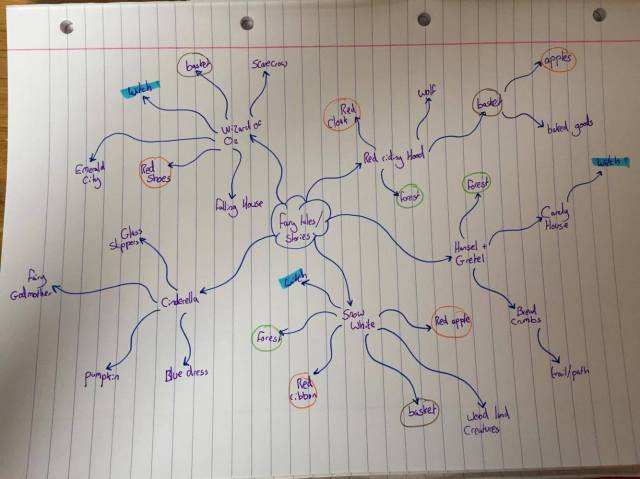
What was made most clear from this exercise was the strong links between Red riding hood and Snow White. The common visuals of a forest and the colour red I think would be a really good tool to help transition and link them together.
From this mind map it feels as though The Wizard of Oz would also link fairly well as it follows the red visuals as well as the basket. I’m not sure wether this would fit as well with the others though because of its story falling slightly outside the fairy tale category and so it would be easier for my audience to become confused.
I think next I will put together a rough structure of how these 3 stories could link together and work in the film.
First rough timeline draft:
This is the first rough draft I have done of the structure and overall content of my film. From my feedback I had decided to use 3 key fairy tales as the basis for my story, in this case I chose Red riding hood, Snow White and Wizard of Oz. I chose these because I felt they had some really strong visuals that I could incorporate and derive links between them from.

Context – Red riding hood – Snow White – Wizard of Oz – Reality
Action – Running from wolf – Abstract forest dance – Talking with scarecrow – Making a brew
Link – Dress torn into ribbon, tie ribbon up – drop apple, pick up apple – scare crow makes kettle sound, props round house (cloak, apple, straw hat)
Good:
- Strong get out/Ending – One of the things from my feedback was the fact that using a train as a location could prove difficult for logistical and legal reasons. I knew that having a non diegetic sound to bring the character and the audience was the way I wanted to go but needed a different medium with which to present this. After considering this I thought that I could use the whistle of a kettle as my sound and bring her back to the reality of her reading a book while making a brew. I really like this idea as making a brew could be considered as a lot of peoples everyday action and so I feel this will be a better link for the theme of reality. As well as a kettle whistle being a really distinctive sound that brings you back to what you were doing which is a similar concept to what I’m trying to represent.
- Visual Links – A key part of my film will be how I choose to transition and link to the various scenes/fairy tales. I started brainstorming any visual connections that I could draw between my fairy tales and settled on a few key aspects/moments. I think that using these visuals will be a great way to show the connection between each fairy tale and transition between them. I plan to research types of match cutting to get a better understanding of how I would do this practically.
- Similar fairy tales – I think what works really well about this structure is how similar Red riding hood and Snow White are to each other. By using two fairy tales so clearly from the same pool means that it will be far easier to draw links between them while also allowing for an all over smooth flowing film as then my themes of fairy tales will be apparent all the way through and clearly established. This doesn’t ring true for The Wizard of Oz however as it falls outside this clearly defined category and therefore could potentially confuse my audience as to the themes of the film and prevent the film from running as smoothly.
- Visual Moments from fairy tales – So that I can clearly establish particular fairy tale/character I am portraying I know that I want to focus on key moments from the stories that are particularly visual/recognizable. This is important as my audience needs to understand and recognize the fairy tales in order to understand the themes of the film.
- Minimal Actors – For this particular story structure it is likely that I would only need two actors to make it work. The main female protagonist and the scarecrow. This would be ideal as it would make organizing shoot days a lot easier as well as replacing any actors that drop out last minute.
Bad:
- Wizard of Oz doesn’t fit – Unlike Red riding hood and Snow White, The Wizard of Oz is not a traditional fairy tale. This means that it could cause confusion within my film as the reason I’m linking between these stories might not be as clear and disrupt the flow. What I did like about this idea was the possibility of developing some humor from the scarecrow character as I thought this would create some nice contrast to the rest of my film. I am still undecided as to wether I can make this work but feel that I should look more into other fairy tales that I could use as well.
- Are the scene changes clear – One of the things simon picked up on when I asked for some feedback on my structure was that fact that it might not be fully clear that I am transitioning between fairy tales and that I should perhaps work on solidifying this idea. I could maybe look at some more abstract camera movements to help show these transitions and that fact that it’s effectively changing worlds. He recommended looking at ‘Stranger things’ and how they show the transitions between scenes.
Timeline Draft

Scene – Red Riding Hood – Snow White – Cinderella – Kitchen
Context – Running from Wolf – Expressive Dance – Forced Perspective Pumpkin – Making Tea
Link – Whip Pan – Whip Pan – J Cut
Good:
- Matching Fairy Tales – I think these fairy tales work much better together as opposed to The Wizard Of Oz. I feel that this is because they all fall under the classic fairy tale category making the link between them much clearer. Also the fact that they all focus on a single female protagonist helps to match the stories together in a much smoother way.
- Whip Pan – After doing test shots and research on a variety of cuts and transitions I have decided to use whip pans as my main method of cutting between scenes. I quite like this cut as it resembles the action and feel of turning a page, further linking in the themes of my story, as well as providing a really clean and smooth transition. Also the actual physical filming involved with creating these cuts is really simple and easy to do.
- J Cut – Another cutting technique I am planning on using is the J cut. This is where the sound from the next scene is faded in before the visual cut to create a different type of transition. I think this will be a really effective way to transition back into reality as the fact that I’m using sound as a method to cut reflects the lack of sound within books and the contrast between the two.
Bad:
- More technically difficult – I’m planning on using a technique called forced perspective as the main focus in the Cinderella scene. Although this is an in camera effect it can be quite tricky to pull of and look convincing meaning that tests shots and substantial planning will be require to make it work.
- Improv Dance – For the Snow White scene I’m intending to use an expressive dance as the focus and film it in a multi camera/music video type set up. My actress is an experienced dancer and so we’ve decided to work around each other and improvise a dance choreography. This could prove problematic having not planning anything definite. However I am still fairly confident as I feel I’ve had enough experience with this type of filming to go with the flow and she is skilled enough to be able to improvise. The way I have planned it is as if I was setting up to film a gig and have laid out my camera angles ahead of time.
- Cinderella loose story – Although I feel Cinderella will work much better and I have a focus point in terms of the stuff I’m doing with the pumpkin and forced perspective, I think the actual context is still quite open. I aim to be pulling inspiration from the suspense/thriller genre and have her sneaking away with the pumpkin in some way but there is not yet a specific action set in stone. This will develop more as I start to do test shoots and story board.
Selection of notes/idea generation
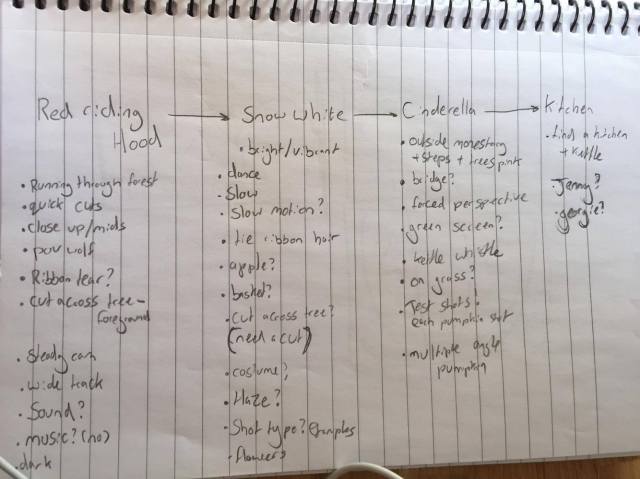

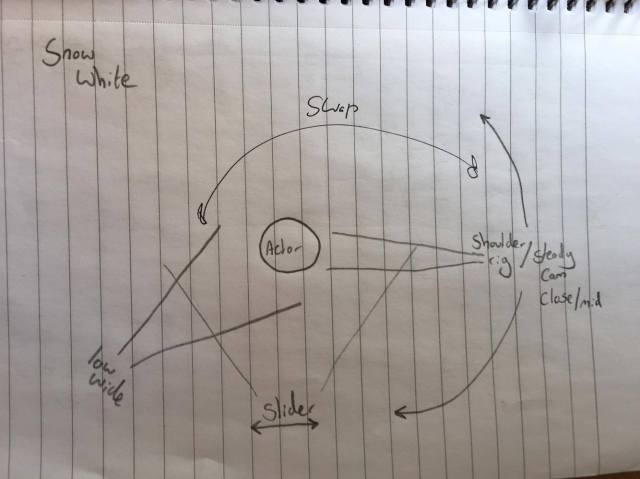
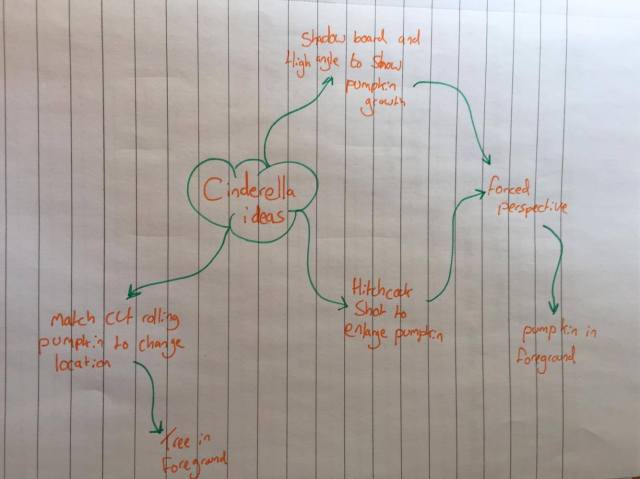
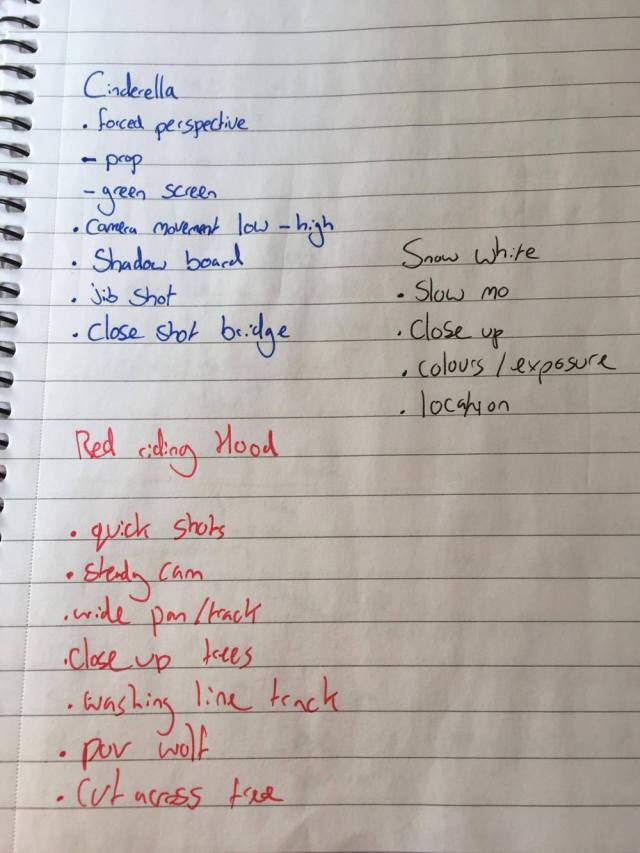
Posted in FMP Year 2
1 Comment
Ideas Generation – FMP Year 2
Summary of the brief:
This project requires me to produce a 2-4 minute film relating to one of the given themes,
Attachment
Flow
Identity
Horizon
I can interpret these themes however I feel appropriate but must document my entire process through pre-production, production and post-production; evaluating each aspect of my work as I progress.
Key areas of this process will include: idea generation, idea development, research and development, screen/shot tests, feedback, pre-production documents, planning, evaluations, rough cuts and a presentation.
14/3/17
Are all humans able to come up with ideas or is it something we can/need to learn?
I think that everybody has the capacity to generate ideas but like everything it becomes easier and quicker with practice. The brain needs to be exercised like any other muscle and will become stronger as you do. Fundamentally I think that people form ideas based on their experiences, places they’ve been, people they’ve met; our whole lives are a bank of information from which to draw from.
What stops you or gets in the way when you are coming up with ideas?
There are a number of things that I am either guilty of or distract me to prevent idea generation. Lack of confidence in an idea is an issue, if I have doubts about an idea it is very easy to sack it off and start trying to think of different ones instead of giving it the chance to develop and see where it goes. Also lack of motivation can be difficult as I think I worry so much about how an idea will turn out and how I’m going to do it that I just won’t start from fear of failure. Pressure is another one for me. When I’m required to sit down and come up with ideas in a designated time I find it difficult as my mind will immediately go blank. Like if someone asks you what music you listen too you instantly forget everything you’ve ever heard. I guess I’m just not comfortable being put on the spot.
What can we do to help ourselves come up with ideas?
Having time to chill out and let your mind run blank is very important to me. I’m guilty of over thinking things or rushing, for example I’ll always be thinking about whats happening later, how I’m going to do it, that guy that gave me a funny look on the bus. It all adds up and clouds my mind until the point that I’m mentally tripping myself up. What helps with this though is being able to take the time to sit and do nothing and forget about the outside world, then I can look at things with a fairly fresh mindset.
Music is another really useful tool for me but a specific kind. While I’m working or trying to think about stuff I can’t listen to anything with lyrics in as I start to focus to my on that rather than what I’m actually trying to think about. I personally find that Instrumental music, especially film scores, really help me to zone out and focus on what I’m doing. I guess in general I work better when I’m able to shut myself off from whats going on around me and get into my own little world.
Tools For Idea Generation
In class we started to look at and explore some possible methods for idea generation to help us with this years FMP.

We talked about traditional techniques such as mind mapping, Brain Storming, Themes and Journalistic Questions as well as ones we hadn’t really considered such as going for a walk, finding a secluded space or yoga.
Some of these techniques that I believe may work for me include:
Mind Mapping – This involves creating a visual representation of the links between themes. I find this valuable as it allows me to get any ideas I have down easily in a way that I can start to look at it as a whole and consider how the ideas link into one another.
Visual Stimulus – This is a technique similar to mood boards. Compiling a collection of images that represent a theme, I find really helpful when generating ideas. It allows me to consider different themes subjectively and derive inspiration from them.
Music – This is a really big one for me. Listening to music allows me to almost zone out from the outside world and focus on whats in my head, I find music helpful when working or doing idea generation because of this. It has to be a specific kind of music however, instrumental music particularly film scores I find to be the best as they are very emotional pieces of music and don’t have lyrics which often distract me.
Make Some Space – This isn’t something I’d really considered as it feels like the opposite of working. Taking time out from life to go for a walk, run or find a tranquil spot allows you to distance yourself from day to day distractions and get back in touch with yourself. We were given time to do something like this in college where we could simply go for a walk alone and think about stuff. I quite enjoyed this approach and think that it is something I will try and keep doing from now on.
Talking it Through – This is something that I generally find helpful in various aspects of life although I am not always the best at initiating it. Being able to talk through your ideas I think can be really valuable as it questions how much you actually understand about it if you’re having to explain something but can also raise new questions that you might not have considered.
Journalistic Questions – I didn’t think that I would find this method that beneficial but was surprised to find out it worked reasonably well. This technique involves asking: How? What? When? Why? Who? in order to help provoke a response to a particular theme or idea.
15/3/17
Free Writing
Horizons immediently sparks ideas about moving forward and reaching towards a goal. While I was on Dom’s nature walk I found it much easier and relaxing without knowing where I was going. I was able to just walk and look as I wasn’t thinking about how to get somewhere I was focusing on the now. I started to look for links in nature that I could relate to life. I saw how the branches of trees scrapped the waters surface and held onto any debree, as though they were cleaning up the river and I thought about how nature can work together to live but people can’t Trees are stood in a moment their whole life and see change everyday. The fact that I could see through the waters surface to the bottom reminded me how everyone is hiding something underneath.
Importance of Imagination
Being able to quickly and effectively generate ideas within film making is crucial because of this it is extremely important to exercise your imagination. This can be done in a variety of ways first of which being idea generation. Sitting down with a list of word prompts or briefs is an excellent way to begin generating and developing ideas. Personally I also find that reading is another useful ‘exercise’ as it requires you to picture scenes and particular ‘shots’ as you digest the story.
I think that imagination is key to being able to enjoy your work as without it you would never have fresh ideas to work with and drive inspiration from, keeping you motivated and invested in what you do.
16/3/17
Word Prompt – Brief
The word that I choose from the brief to act as a stimulus for idea generation was ‘Horizons’ and so began using a number of techniques to start the process.
Horizons – The line at which the earth’s surface and the sky appear to meet.
Mind Maps

I found this technique very useful in exploring the relationship between themes and how I can expand on them. I like the idea of incorporating ‘boundaries’ and ‘freedom’ into my film and want to explore these themes further.
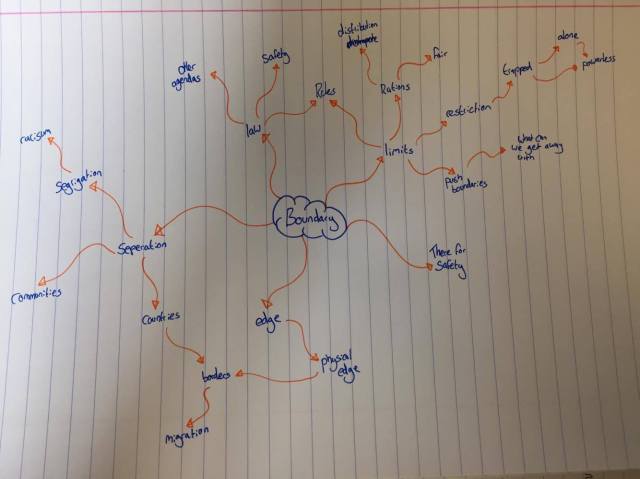
I decided to create another mind Map in order to explore the theme of boundaries this led me onto various other themes as well as limits and rations which sparked an idea around a story my Grandpa had written to do with sweet rationing.
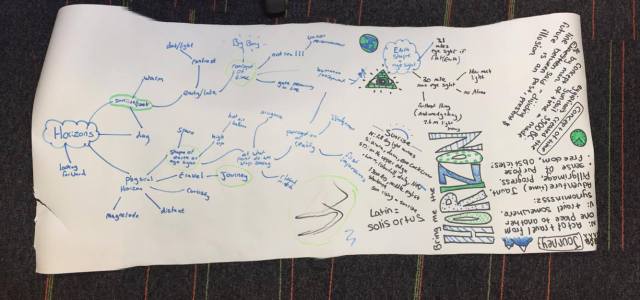
Visual stimulus
Before I started and during mind mapping I compiled a selection of images to do with the theme Horizon in order to help prompt me for ideas and themes. When looking at images such as these I like to imagine how I would feel in that place and that process I find helpful when generating ideas.
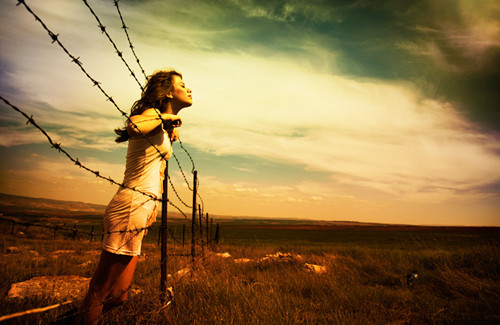
My mind map lead me onto the idea of freedom and while I was thinking about that theme I came across this image. It stood out to me because I think it represented the idea of being blocked from your freedom or from moving forward, a theme which came while I was exploring ‘Horizons’
Idea 1 – Grandpa’s Story
One possible idea I’ve had for my FMP is an adaptation of a story my Grandpa wrote. While I was exploring aspects of the theme ‘Horizons’ I came across the motion of moving forward or progressing from hard times into something new. This got me thinking about a fictional story by my Grandpa which follows a Magic Intelligence agent (MI7) as he investigates the use of illegal magic during the 1943 Sweet rationing.
A Mr Goblin is a bumbling magician accused of producing extra sweets for children through the use of illegal magic. He then distributes these sweets over the mountain CatBells for local children.
Basically this is how he convinced me and my sister to go walking as young children.
Arthur Beasley is an MI7 agent who investigates this accusation.
If I follow this idea however some aspects of the story will have to be simplified in order to fit the brief of 2-4 min. I started by highlighting parts of the story that I felt were significant and began to produce a mind map and mood board in order to get a little more inspiration for the idea as well as get a feel for it.
Grandpa’s Story

Mind Map – Sweet Ration Story

Mood Boards – Sweet Ration Story


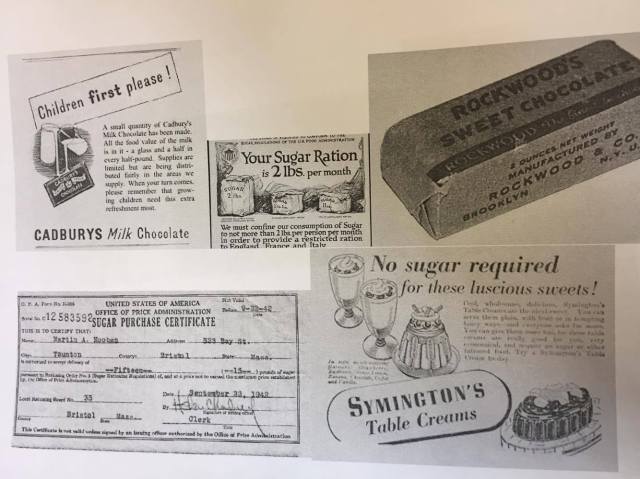
These will help me to visualise aspects of the story and hopefully make more informed decisions about how to go about it.
21/3/17
Idea 2 – Transported into book
This particular idea was inspired by some of my mind maps I had created for ‘Horizons’. I came across the theme of ‘perspectives’ and how people view the world differently, I thought that I could use the idea of traditional stories/fairy tales to explore this and that books can represent the boundary or horizon between imagination and reality.
This idea would involve my main character being transported into this world and witnessing these stories unfold from a far. I would focus on key moments from the stories and show them in a combination of out of focus/wide shots. For example with ‘Little red Riding hood’ I would focus on the visuals of the red dress and forrest while possibly going for a more sinister feel and heavily use sound to create the atmosphere and link in the wolf from the story. With this kind of structure I could take my character through various locations and stories with the chance to explore different styles and meanings within each one.
I feel that this is an idea that I could get really invested in and gives me a plenty of room to experiment a bit and try a combination of styles. I also feel that it fits the brief well, in terms of ‘Horizons’ I will be exploring how things are perceived as well as the boundary between real and make believe. Also this is an idea that I think would work with the 2-4 min brief giving me just enough time to develop the story without it becoming monotonous.
Mind Map – Book Transport Story
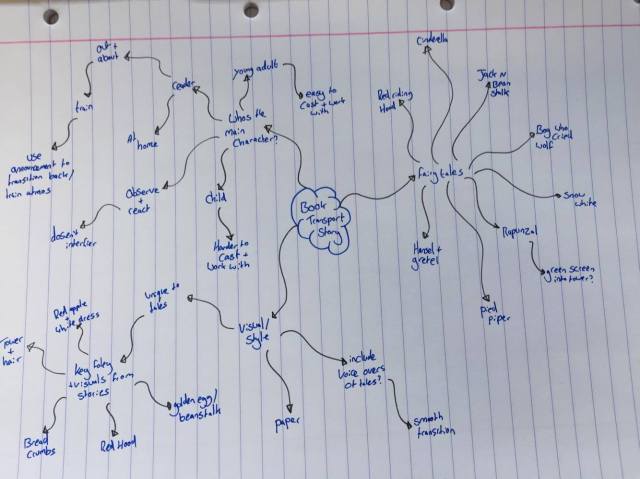
Mood Boards –
Idea 3 – Little Miss Muffet
This idea came from thinking about the themes of ‘boundaries’ and being on a ‘mental edge’. I had an idea a while ago for a simple film following the nursery rhyme Little Miss Muffet. I thought this would be a good one to concentrate on my cinematography and shot types to tell the story as there isn’t a lot of content. Once I started exploring the brief however and arrived at the theme of edge or how someone can be on a mental edge, I thought I could use this idea to explore that theme. The spider I thought could perhaps be the embodiment of her fear and anxiety and I could even explore the idea of PTSD and possibly present this story as a sort of flash back to a traumatic event.
This idea would be heavily focused on character development and I would have to find a way of making her relatable and understood. From the brief ‘Horizons’ I landed on the theme of looking forward or moving onto something better. This story could be a way of showing that progression while also touching on the idea that you never really leave your past behind you, as it shapes who you are.
Little Miss Muffet
Sat on a tuffet,
Eating her curds and whey;
Along came a spider,
Who sat down beside her,
And frightened Miss Muffet away.
Mind map – Little Miss Muffet

Mood Board –
Why do we tell stories?
- Document Life
- connect with people
- create an emotion
- validation
- share experiences
- pass on information
- send a message
- to remind us
In class we talked about how stories need to have some kind of emotional arc or resolution, this may be in the form of, Beginning middle and end. This means that you are taking your audience on a journey as a story develops until you arrive some where different but that stills relates to the beginning.
Im not completely convinced but I also that that there may be some benefit in cutting a story arc short. Say if your story is following a very contemporary structure and your audience is expecting the hero to get the girl and live happily ever after; is there not some value in falling short of this and not resolving the story? Almost snapping people back to reality. I do think however that the most successful or understood stories follow an emotional arc and allow their audience to feel some kind of closure.
An emotional arc is different to the structure of the film. You could for example only show the ending of a story while still having a complete emotional arc within your film. I think the easiest way for me to understand this is to say the beginning, middle and end format is used to structure your story into chronological events; where as an emotional arc is the structure of the audiences experience.
28/3/17
Shapes exercise – Thinking Visually
This is a simple exercise we did in college in order to help us think about how we can document our progression visually. This particular exercise is closely related to how we can provide evidence of our shot choices for a certain setting or object.
We had to choose a shape/object with which to show the progression of our shot choices:
Arch window –
Fire Alarm –
Drain Pipe –
Posted in FMP Year 2
1 Comment


























































































































































































